Diversity in Tech
An annual report tracking diversity in technology across the UK
.png)
Tech innovation offers a powerful opportunity to positively influence every aspect of life - from the global economic picture to everyday individual experiences - so it’s vital that the UK develops a strong tech ecosystem to enable change.
The Department for Science, Innovation and Technology estimates the digital skills gap costs the UK as much as £63 billion a year.¹ Crucially, if we are to start closing this gap, leaders must recognise that all efforts to increase productivity hinge on how successfully we enable people from all parts of society to contribute to and benefit from the tech economy. In service of this aim, the Tech Talent Charter (TTC) is pleased to share our annual Diversity in Tech report.
Though the TTC Signatory base continues to grow, with 580 organisations submitting data last year rising to 649 this year, the D&I agenda faces serious challenges. As budgets are squeezed by tough economic circumstances, we are increasingly concerned that D&I work is being relegated to a side project, often on the desks of the employees they are supposed to support. There is continued pressure on middle managers to deliver results, sometimes at the expense of inclusive culture. We are also hearing how numerous mergers and acquisitions are affecting companies’ ability to prioritise D&I and participate in the TTC and our activity. So although this report represents the many organisations who are leaning into D&I, we must not be complacent if we are to continue to see meaningful D&I progress.
Despite these challenges, there is cause for hope. D&I in tech has previously struggled with reductive attempts to “just hire more women” but we now see a much more holistic approach to increase underrepresented groups’ engagement in the tech talent market. Many Signatories recognise that to attract and retain an in-demand and diverse tech workforce, they need to work on multiple lenses of inclusion at the same time, and at all levels of their business, to build their understanding of how these lenses interact throughout a career journey.
Pay gap reporting in particular continues to sharpen focus on diversity in senior roles and organisations are zeroing in on the need to improve not only the opportunity for underrepresented groups to get into tech, but also the culture they experience when they land, how they are developed, promoted and retained. Having reported last year that diversity in senior roles was one of the biggest challenges organisations face, we are pleased to share that a significant number of Signatories responded to our call to report a new data point to us: the gender diversity and ethnic diversity data for their most senior tech employees.
Signatories’ support and willingness to provide more data led to our expansion of the D&I survey, which for the first time includes questions on eight diversity lenses. This has enabled us to provide wider insights and dig deeper into burgeoning areas of D&I practice, such as neurodiversity and reproductive health. But crucially it has also allowed us to highlight the areas where work is still lacking, such as in social mobility.
Armed with these insights, the TTC will redouble our efforts to support our Signatories and the wider business community with D&I resources that can make a difference: alongside this report, we are pleased to launch a new dynamic benchmarking calculator to enable organisations to see how their D&I efforts compare against other organisations in their sector, size category and region; we are also continuing our commitment to support pathways into tech careers via our Routes to Tech workstream; we have worked to build and curate new D&I resources, such as our recently launched podcast; and we look forward to sharing with you our new programme of in-person and virtual events for the year ahead, including a regional roadshow.
The publication of our sixth report - the widest and deepest yet - would not be possible without our sponsoring partners: the Department for Science, Innovation and Technology, Global, HP, Lloyds Banking Group, Nominet, PwC and CWJobs. Our special thanks go to these organisations, and our other key partners who have provided us with industry expertise and support. Finally, we would like to thank our Signatories, and in particular, the passionate and devoted individuals who work on D&I who have put in the time and effort to supply us with the data upon which this report is based: more than anyone, this report is for you. As you know, there is much to celebrate, but still so very much to do.
¹ https://www.gov.uk/government/news/new-digital-strategy-to-make-uk-a-global-tech-superpower

Paul Scully MP, Minister for London and Parliamentary Under Secretary of State at the Department for Science, Innovation and Technology
Our tech sector is one of the strongest in the world, and is vital for driving growth and jobs across the entire country. But it is no secret that the industry faces a diversity crisis. Despite the advancements made in recent years, the fact remains that UK tech is still not representative of the UK as a whole.
One of my main priorities as Parliamentary Under Secretary of State for the Department for Science, Innovation and Technology is to give people from every walk of life and every part of the UK the skills to not just enter the world of tech, but rise to the very top.
That is why Tech Talent Charter’s ‘Diversity in Tech Report’ is so important. It provides us with hard evidence that gender diversity decreases by 5% for senior tech roles, while ethnic diversity decreases by 12%. This is not only unjust; it is bad for tech. It is holding back our full potential for innovation and growth.
So, what can we do to change things?
I am proud that the government has supported the Tech Talent Charter for the past six years, and are proud signatories of the charter - meaning that we have publicly committed to diversifying our workforce. I strongly urge other organisations to do the same.
My department will continue hearing from and working with the sector via the Digital Skills Council, to ensure that growing the digital workforce is driven by the needs of both businesses and those from underrepresented groups.
We all have an important role in reaching this goal. I hope that this report generates action to build on the small successes that we are seeing, and continues to break down the barriers to access and promotion for underrepresented groups. Together, we can open up UK tech to new faces, and turbocharge the success of the entire industry.

Top 10 findings
The central purpose of this report is to provide insights that will help organisations improve D&I by sharing knowledge across the tech ecosystem. It provides up-to-date statistics on diversity in tech, along with a diversity benchmarking calculator - with insights by region, industry and team size - and offers ideas for further consideration and action.
Our findings are based on survey submissions from 649 organisations, employing over 930,000 people and over 210,000 tech employees, making this survey one of the largest, broadest and most up-to-date analyses of its kind.
Some of the ways we hope you will be able to use this report are:
- To make a business case for D&I activity in your organisation.
- Benchmarking your organisation’s diversity to others in your region, sector or size bracket.
- Sharing it as a resource to provide context on D&I to stakeholders in your organisation.
- Finding out about new lenses of D&I practice and how to start addressing them.
- Gathering insight into D&I activity and trends across the tech ecosystem to inform your future plans.
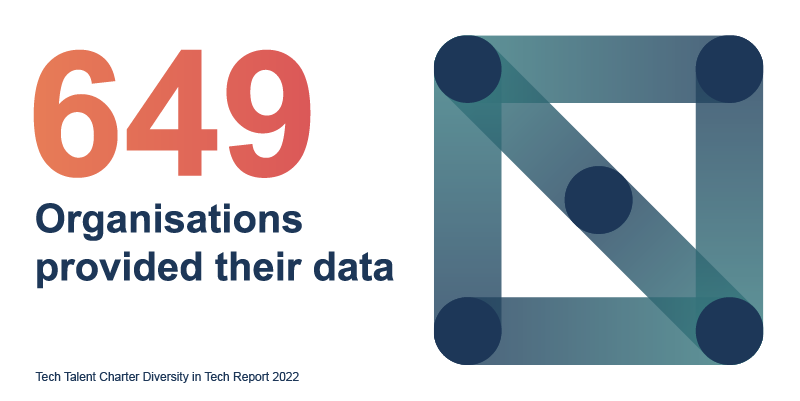
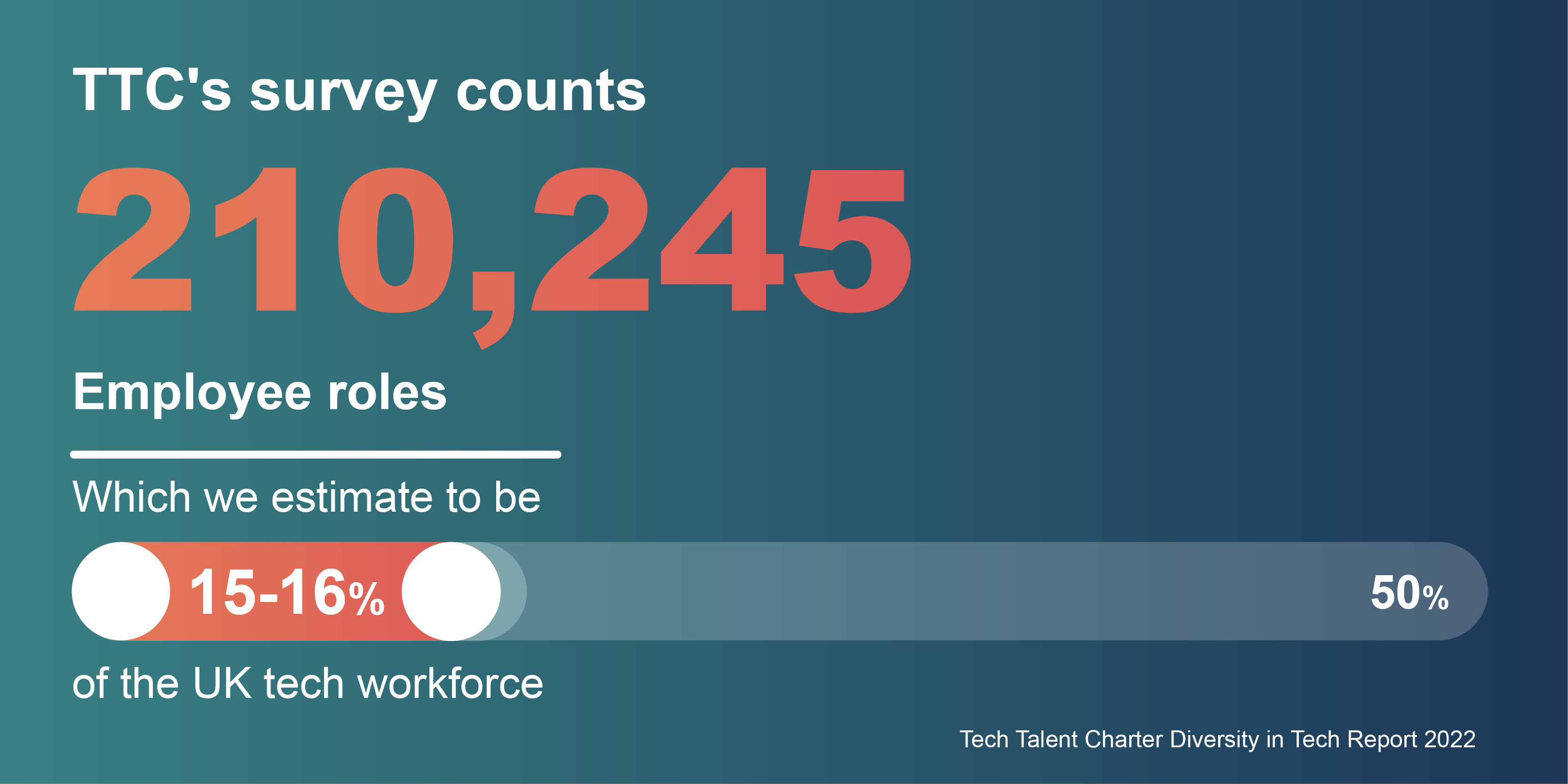
Our ten key findings are:

.png?width=1200&length=1200&name=Teaser%20post%201%20(2).png)
.png?width=1200&length=1200&name=Teaser%20post%201%20(3).png)
.png?width=1200&length=1200&name=Teaser%20post%201%20(4).png)
.png?width=1200&length=1200&name=Teaser%20post%201%20(5).png)
.png?width=1200&length=1200&name=Teaser%20post%201%20(6).png)
.png?width=1200&length=1200&name=Teaser%20post%201%20(7).png)
.png?width=1200&length=1200&name=Teaser%20post%201%20(8).png)
.png?width=1200&length=1200&name=Teaser%20post%201%20(9).png)
.png?width=1200&length=1200&name=Teaser%20post%201%20(10).png)
- 28% of tech workers are gender minorities, slightly higher than past years (+1-2%).
- Only 35% of companies are measuring non-binary gender diversity.
- 25% of tech workers belong to ethnic minority groups, compared to 20% reported last year.
- Average disclosure rates for ethnic identity are at 76-86%.
- 22% of senior tech roles are held by gender minorities - 6% lower than tech roles overall.
- Ethnic diversity almost halves in senior roles from 25% to 13%.
- D&I measurement and practice on social mobility lags far behind other areas including age, religion and orientation.
- Flexible work options are widely available for tech employees and nearly half (47%) have the option to remote work as much as they like, from wherever they like.
- Neurodiversity emerged as a distinct area of interest; the number of organisations measuring it doubled to 53%, compared to last year.
- Mental health and wellbeing and reproductive health issues such as menopause and fertility are areas of focus for many organisations, especially in relation to gender, age and LGBTQ+ inclusion.
What types of D&I data do Signatories have?
In order to improve D&I practice and results, it’s crucial that organisations not only collect D&I data, but analyse and act on their findings. One of the reasons TTC requires data from Signatories is to ensure they are engaging with their D&I data. Whilst companies are at different stages in their D&I journeys, with some collecting more data than others, we continue to monitor which diversity lenses Signatories are measuring. Through this exercise we can see maturing attitudes, approaches, and investment in D&I data collection across a number of D&I lenses.
The measurement of all lenses of diversity was significantly higher compared to last year’s survey data. More than nine out of ten Signatories now collect data on ethnicity, which is up by a third compared to last year’s data. And 53% are now collecting data on neurodivergence - more than double compared to last year. The only diversity characteristic still not being measured by the majority of Signatories (62%) is socio-economic background.
Against the backdrop of a cost of living crisis and lengthy economic recession, it’s more important than ever that businesses develop better understanding of how wealth and opportunity affect their current workforce and future talent supply, and how this issue intersects with their efforts on other diversity issue areas.
Knowing more about what Signatories are measuring, we’ve deep-dived into what they are actually doing on each of these areas.
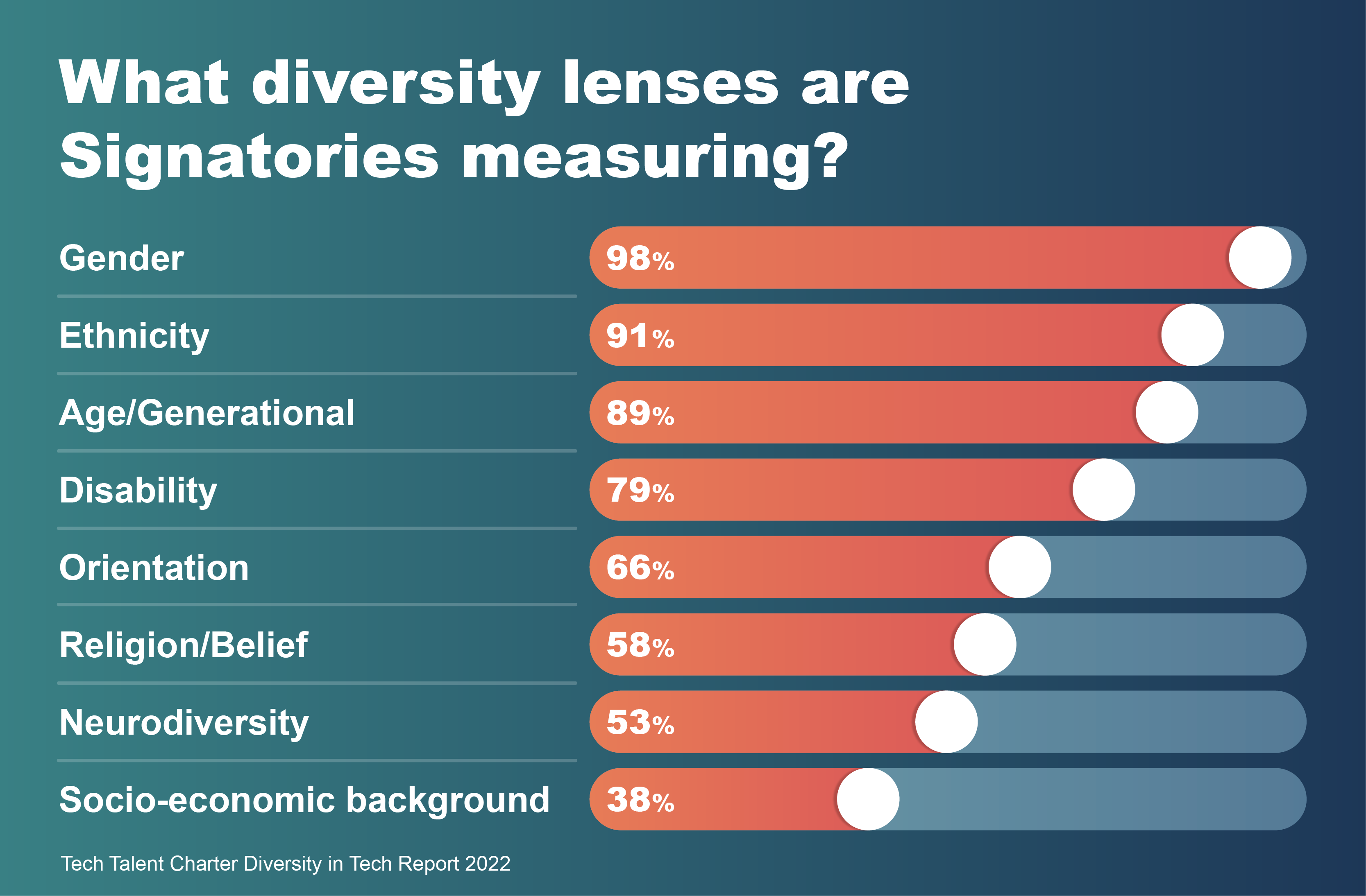
Use our interactive benchmarking tool to compare your D&I efforts to TTC Signatories in your industry, region and tech team size.
The ten different lenses of D&I practice included in this report
Gender
Gender
Of all diversity lenses, gender remains the top area of concern for many of our Signatories, and with good reason. Gender minorities remain drastically underrepresented in tech, compared to the wider workforce, despite years of effort to improve. Relative to data on ethnicity, disability, and age, this is by far the most striking disparity for the tech industry. The cost of underemploying gender minorities in tech is sobering. A recent report by Code First Girls and Natwest highlighted that if we were to achieve gender parity in tech, it could add an additional £2.6bn to the UK economy.
TTC Signatories continue to outperform the average on gender diversity: 28% of Signatories' tech employees were reported to be gender minorities. This is slightly higher than previous years (26-27%), and across such a large dataset, this is not inconsiderable. But the inertia of gender diversity is a challenge and frustration for many.
The challenge with improving gender diversity in tech is that it cannot be solved just by trying to hire more women, yet unfortunately many organisations are still making this the sole focus of their efforts. In order to improve both supply and diversity in the tech talent market, we need to look at three broad issues:
- increasing the number of gender minorities entering the tech labour market
- ensuring they have the right skills at a work-ready level to do the tech jobs that industry needs and
- ensuring that employer and industry-wide culture is one that draws them to stay.
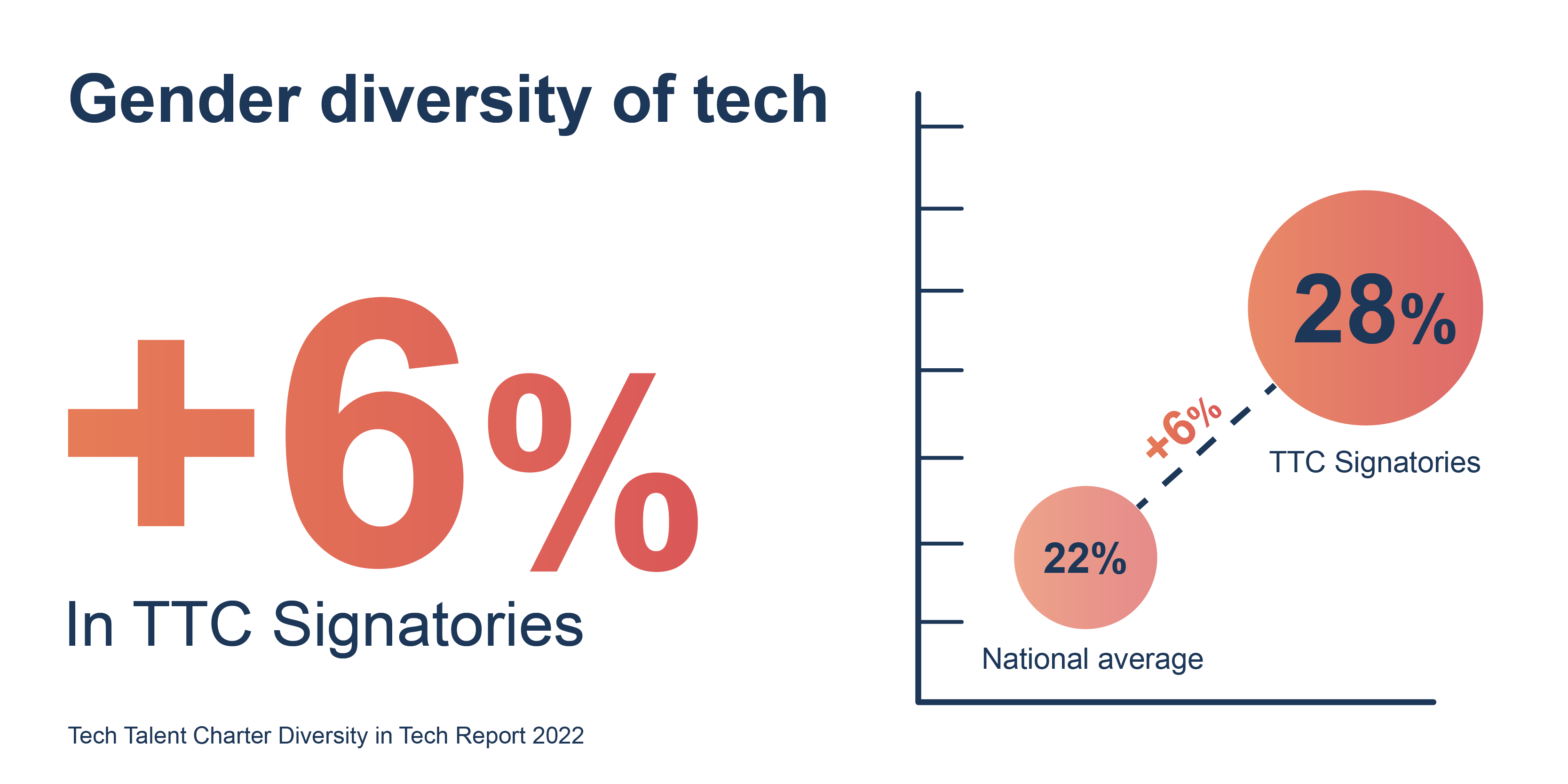
.png)
“Despite diversity being high on the agenda, the number of women working in the tech sector remains low: they make up just 18% of software development professionals and data analysts in the UK. The UK’s education system is guilty of failing to support women and people from more diverse backgrounds into tech, and there remains a preconception that tech is an industry for men, with female role models few and far between.”
- Anna Brailsford, CEO of Code First Girls
Many organisations seem to be focusing entirely on point one (candidate volume). However, it’s essential that we also look into more overlooked problem areas too. Within tech, different occupations have different levels of gender diversity. TTC research in previous reports found that roles associated with “hard skills”, like software engineering and IT operations, are more gender-skewed than areas like user-centred design and software testing. If we are to meaningfully address the tech gender gap, D&I tech skills initiatives must engage women with the tech skills required for the most in-demand and highly-paid tech occupations.
The final side to the gender diversity triangle is retention. Research by We Are The City and Ipsos Mori found the main factors driving women to leave their tech jobs were poor promotion opportunities, lack of support from senior leaders/role models, difficulty balancing work with other commitments and sexism/gender bias. Unless organisations tackle attrition by identifying and addressing the disincentives and barriers women face, investment in recruitment and skills will never deliver their full potential.
Beyond the binary
In our survey we asked Signatories to report non-binary gender identities. However, almost all of the gender minority sample reported back to us were women; less than 0.1% were reported to be other gender minorities. Unfortunately, this is most certainly impacted by the fact that only 35% of Signatories report that they even measure non-binary genders. Medium and larger organisations tended to do better at measuring non-binary genders, with around 40% seeking to include these identities in their data practices. However, amongst small and micro-size organisations, only one in four did so. For those that do collect non-binary gender data, the proportion of non-binary tech employees they reported was similar to, though slightly lower than the population averages, at 0.4%.
The most recent UK census was the first to collect data on gender identity and it found that 0.5% of people identified as trans. With UK-wide insights like these cementing gender identity in the public eye, companies need to invest in updating their data collection systems and attitudes unless they wish to fall well and truly behind the curve.
What's in a D&I plan?
We've identified a set of foundational inclusive practices that support inclusion across many diversity lenses irrespective of team size or budget. Learn from organisations that are leading the field with their D&I practice.
Senior tech employee gender diversity
We asked Signatories to provide data on the gender diversity of their senior tech employees. Several organisations fed back to us that this was the first time they had explored diversity in a more nuanced way, across multiple senior tiers and specifically in tech functions, rather than just their C-suites. From a sample of over 11,000 tech employees submitted by 86% of our Signatories, we found that gender minorities accounted for 22% of senior tech positions - 6% lower than in the wider TTC tech workforce.
Poorer diversity at senior levels compared to Signatories’ overall tech workforce reflects findings from the TTC’s last survey, which identified D&I in senior positions as one of the most frequently reported areas of concern. It also correlates with many Signatories sharing that they have set targets to achieve a more balanced gender ratio, typically between 40-50%, within a period of three to five years.
Encouragingly, the proportion of women in senior roles appears to be far higher than comparable estimates five years ago. However, the bad news is that compared to all senior business roles, diversity in senior tech positions lags by a decade.
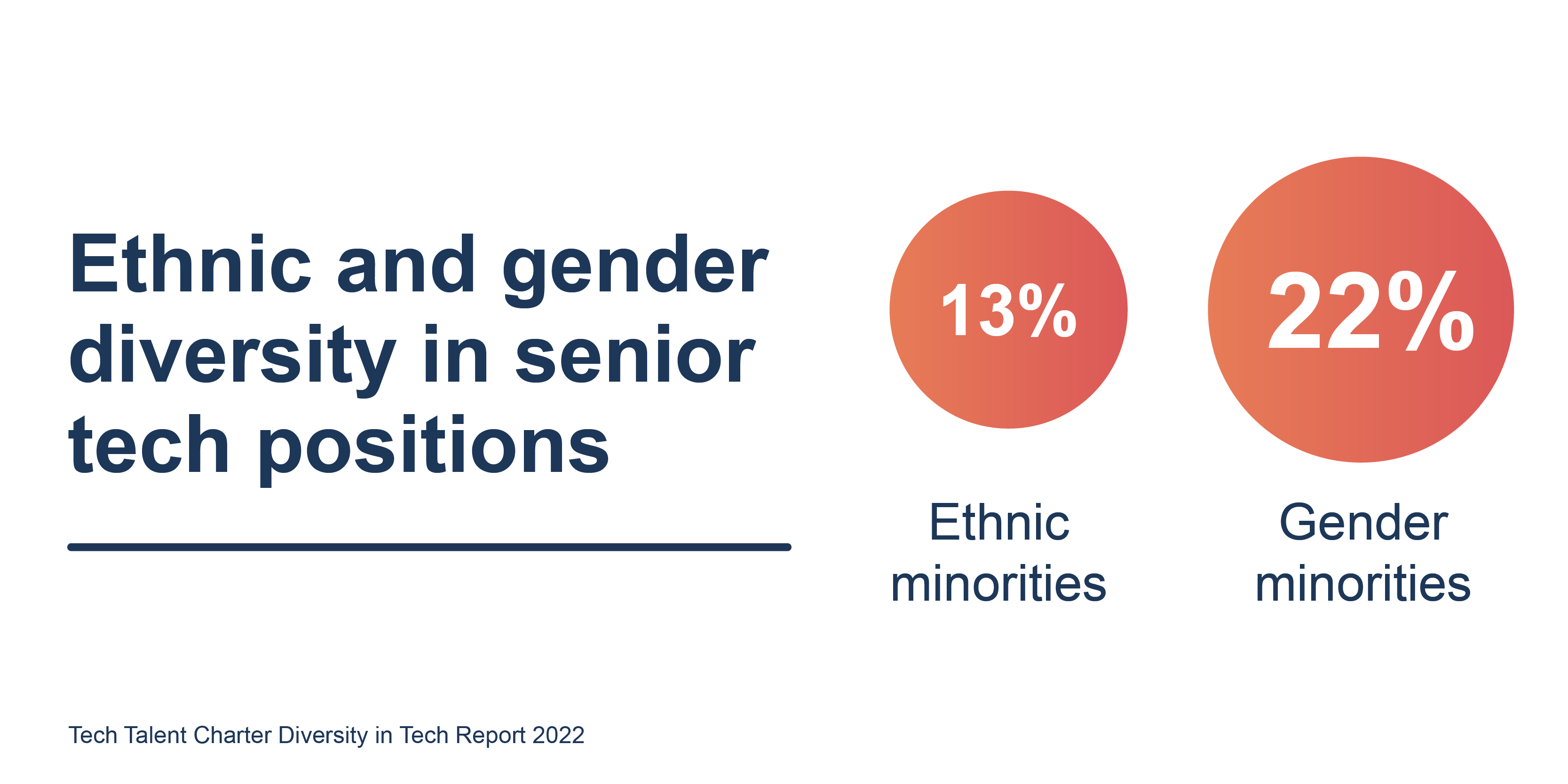
TTC Signatories have set targets to achieve a more balanced gender ratio, typically between 40-50%, within a period of 3-5 years.
What our Signatories are saying about…
The importance of pipelines and progression
“We first set gender targets for the proportion of women at grades manager to partner in 2015 to be achieved by 2020. We have now reset further stretching gender targets to be achieved by 2025 for all grades to partner. Our partners are held accountable for the delivery of their local gender targets though their performance and reward framework. Our targets and progress against them is published in our Annual Review and we’re on track to achieve 2025 gender targets across all grades.”
PwC

“Having clear goals that are widely shared amongst your business and even externally can help mobilise leaders and teams to reach their diversity, equity and inclusion (DEI) goals. HP have publicly announced clear DEI 2030 goals, which include achieving 50/50 gender equality in HP leadership. Each of our people managers from global to local leaders have their own DEI goals as part of business reviews, and by specifying local measurements it focuses the minds of our leaders to make timely decisions that ensure progress towards a balanced future.”
Debbie Irish, Head of HR for UK and Ireland at HP

Gender: what are Signatories doing?
Gender diversity remains a top priority amongst many Signatories. Nearly nine in ten respondents reported D&I activities on gender, compared to one in two for other diversity areas. We asked Signatories to tell us what D&I practices they use to improve gender diversity and found that the most common initiatives were employee networks (also known as employee resource groups, or ERGs). Creating supportive spaces for employees with shared experiences to bring their perspectives to work is highly valuable for increasing employee engagement and fostering inclusive culture. These can be most impactful when they have senior sponsorship and education for allies too. However, it’s important that employee networks are not treated as a free replacement for proper investment in D&I practices, especially when the employees involved in them are likely to be from minority groups.
The next most common interventions were neutralising gendered language in job ads, flexible working initiatives and family-friendly policies and benefits. All of these policy and procedural interventions are now well-known for improving gender diversity, by addressing barriers that fall along gender lines. Yet, our survey revealed that some organisations are only using a single intervention in isolation and this speaks to a lack of understanding of the tech talent pipeline as a system. Having policies like this are valuable and important; but to get the best from them, they need to be accompanied with changes that address deeper issues that emerge in their wake.
For example, gender-neutral job ads do result in more women applying for a job. But improvements will be lost unless employers remove barriers within the workplace that hinder women from thriving and progressing. An organisation may therefore implement flexible working policies to better accommodate women who typically shoulder the bulk of caring responsibilities. This is another great step, but it needs to be coupled with action to tackle the persistent stigma attached to part-time work, whereby career-development opportunities are directed predominantly to full-time employees.
Gender diversity is one of the most mature areas of D&I practice, with research on the topic generating a number of effective interventions. What separates the leading employers from the rest is that they have applied deeper and systematic thinking to their D&I practices to ensure that gains made during key stages of an employee career journey are not lost later down the line as a result of biassed processes or culture. Lesser mentioned but a great example of this were companies with ‘fair work allocation policies’, to ensure that career-elevating projects were spread proportionally amongst employees, including those who work part-time.
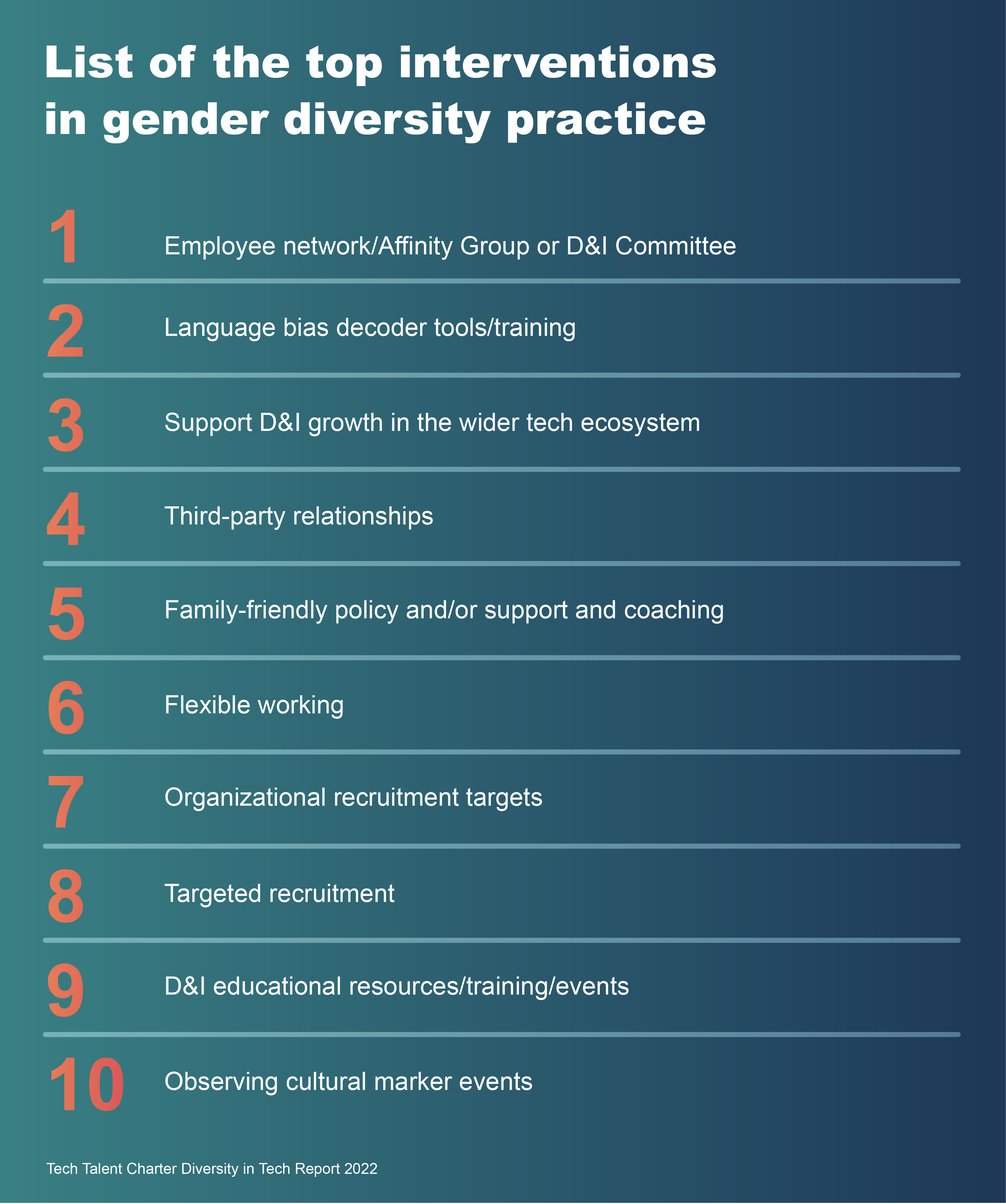
“Ground-breaking research into gender-neutral language in advertising that was commissioned in Openreach in 2021 led to revamped job adverts. An innovative subsequent campaign successfully attracted 300% more women to engineering roles.”
Steve Cunningham, Director of Organisational Effectiveness and Talent at BT Group
“To support their progression it is important that our female talent has fair access to career-enhancing roles, opportunities and a work portfolio that supports their development. Our Resourcing teams monitor fair work allocation and to ensure the gender profile of engagements is proportionate to the profile of the business and use the data to intervene where this isn’t proportionate. Our leaders are also held accountable to ensure a fair work allocation approach is delivered across all of our business areas.”
- PwC
Underserved health journeys
Reproductive health emerged as a leading area of innovation amongst Signatories with the most robust gender inclusion activities. Menopausal women are one of the fastest-growing demographics in the workplace but, research by CIPD found that 1 in 4 menopausal women say they don’t get the support they need from their manager. Knowing that retention of gender minorities and gender diversity in senior roles are key focuses for so many organisations, investment in menopause inclusion is a crucial way to support and retain colleagues experiencing this life stage during their career.
41 companies highlighted initiatives to support menopause. Many of the same group also provided support for other underserved health journeys, including gender reassignment, infertility disease, fertility journeys, pregnancy loss and innovative enhancements to parental policies. Presence of these policies was also correlated with better gender diversity at the company overall. Work in these areas was highly intersectional, with companies detailing how they considered their employees' experiences of these issues through an LGBTQ+ lens, as well as age, and the cisgender experiences of both men and women.
As with any policy, reproductive health benefits have the most meaningful impact when they are widely-communicated and the process for accessing support is clear and straightforward. By taking steps to integrate these life stages into company policy and culture, employers will enable their staff to manage some of the most persistent and tough work-life balance challenges.
1 in 4 menopausal women say they don’t get the support they need from their manager.
What our Signatories are saying about…
Supporting reproductive health at work
Shell
Futureheads
Direct Line Group
Joining the dots: gender
There’s fantastic work going on in our Signatory base on gender inclusion.
If you want to explore any of the ideas mentioned in this section, we have compiled a list of organisations, resources and partners our Signatories said they worked with on gender inclusion. You can also find a wealth of resources on Gender in the TTC Open Playbook.

Ethnicity
This was the second year we asked companies to report data on ethnicity. For the 137,000 tech employees who responded to a D&I survey about their ethnicity, over a quarter identified as being part of an ethnic minority group. This compares impressively to the wider tech workforce, which was estimated to have 18% ethnic minority representation in a 2020 study by BCS. Individual ethnic groups are also represented proportionally inline with or above overall workforce averages. Of course, we must acknowledge that ethnicity classifications are imperfect groupings that not every individual may comfortably fit into, but they allow for comparisons and the identification of trend data, which help us to understand progress being made by signatory organisations and across the industry more broadly.
However, as with many tech surveys, our data is weighted toward London and the South East, with 46% of tech roles in our survey from the area. In London the proportion of people who identify as Black is estimated to be 13%, far higher than the nation-wide figure of 3%. Given that nearly half of our sample is from London and the South East, we would expect Black representation to be higher, reflecting the regional demographics. However, our survey only shows Black representation to be marginally higher, at 4%. Therefore, it’s essential that organisations seek a deeper and more nuanced understanding of ethnic, cultural and racial disparities in their environment, and take thoughtful and decisive action to improve engagement and access where it is needed.
Use our new dynamic benchmarking to compare your organisation's ethnic diversity by region
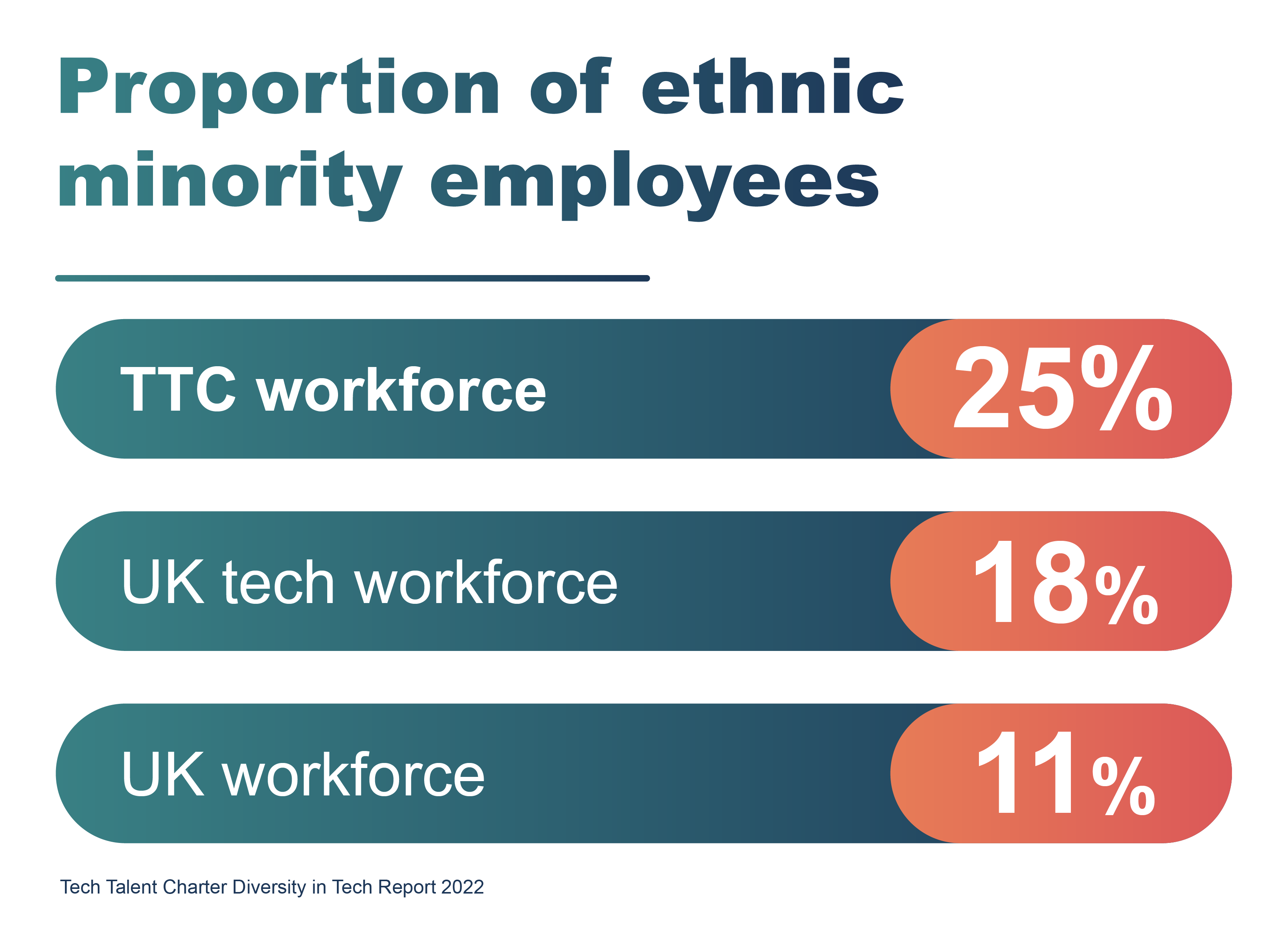
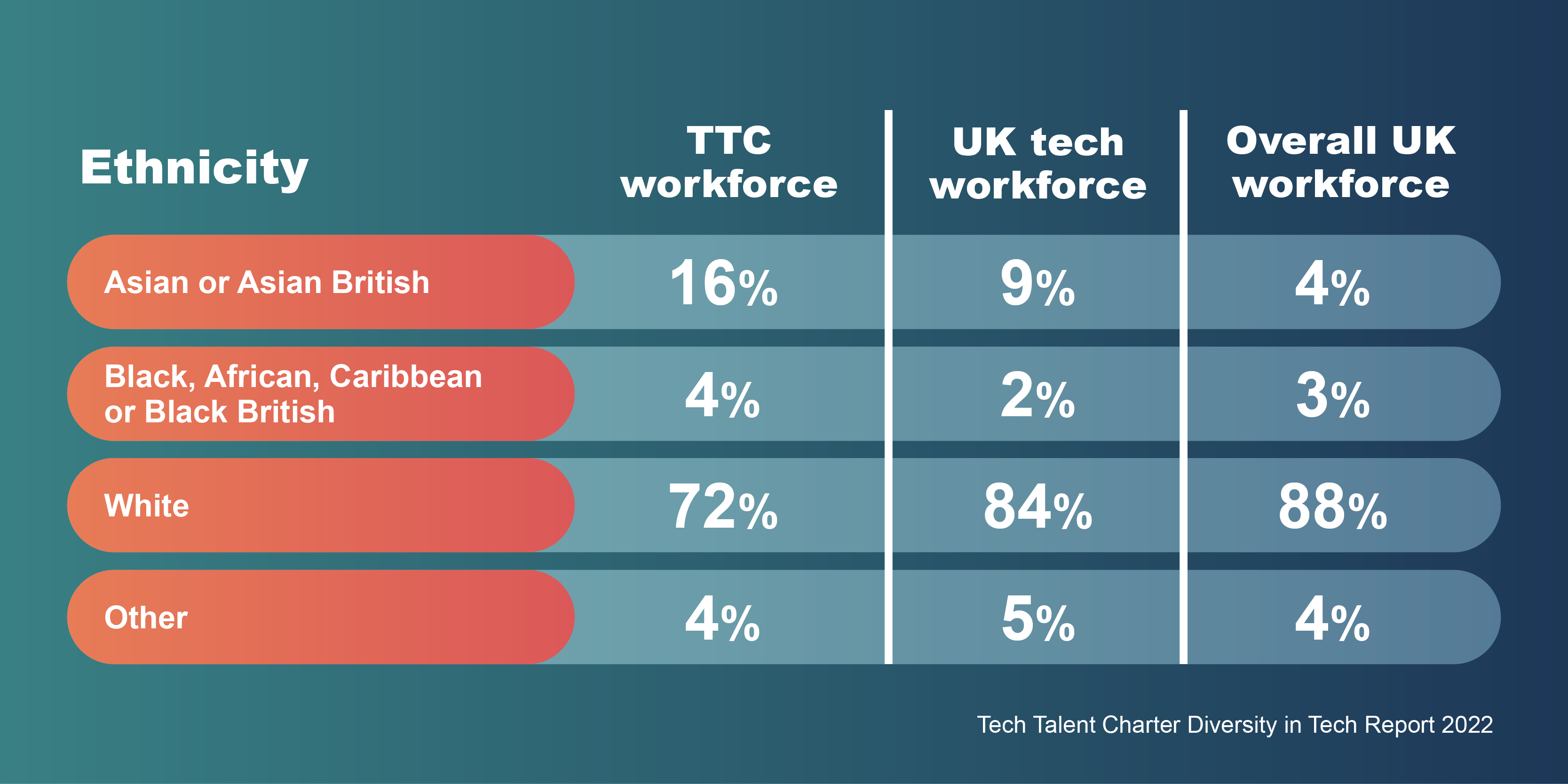
Ethnic diversity in senior roles: not all diverse talent pipelines are created equal
As with gender, measuring overall workforce diversity data is only the first of several critical data points towards better ethnic inclusion. What’s just as important in this area of practice is understanding not only who is getting in, but who is getting on.
We asked Signatories to provide data on the ethnic diversity of their senior tech employees. From a sample of over 11,000 tech employees submitted by 86% of our Signatories, we found that 13% of the most senior tech employees were ethnic minorities - close to half the proportion who are in the tech workforce overall. This alarming finding clearly demonstrates that ethnic minorities may be doing everything right to get into tech, but when they’re here, they are not finding equitable career progression.
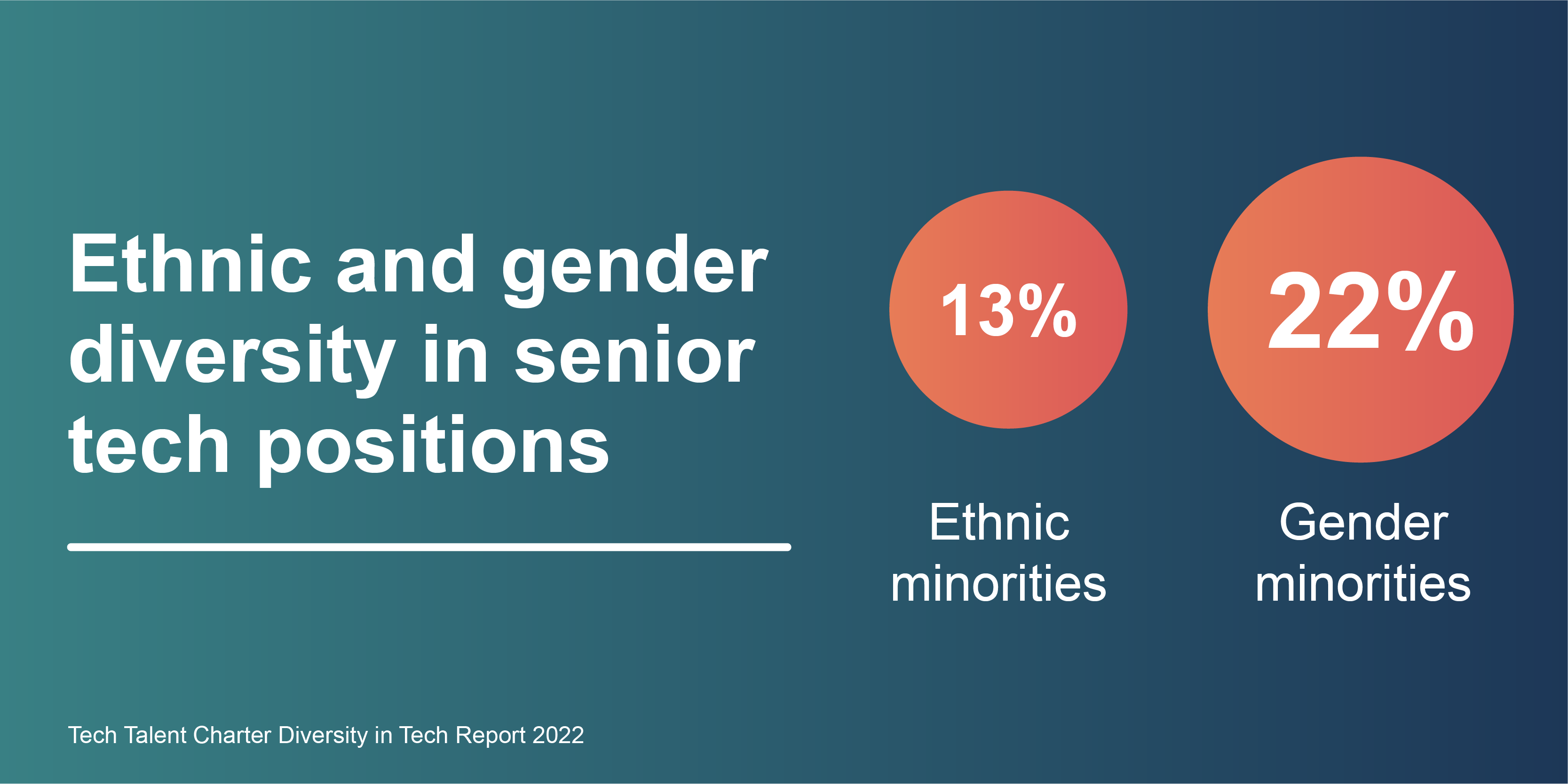
Though unwelcome, it’s unlikely to be news that diversity in senior roles is low. However, what is more surprising is the finding that ethnic minorities drop far more sharply in senior roles than gender minorities do. The proportion of ethnic minorities reported to be in tech roles (25%) nearly halves in senior tech roles (13%) whereas gender minorities drop by a much less precipitous 6%, suggesting that progression or retention into senior roles may be a more acute challenge for those from ethnic minority communities. Whilst lower gender diversity in senior roles can partially be explained by more experienced employees taking career breaks for caring responsibilities, the drop in ethnic diversity can’t be explained by a similar practicality, and highlights very troubling questions as to why this is the case.
The kernel of hope in this finding is that whilst there is significant and urgent work to be done on progression for ethnic minorities, by learning from gender diversity practice at senior levels, we may be able to greatly improve ethnic diversity in senior levels for the 1 in 4 ethnic minority employees already working in tech. With the statistics laid bare, it’s crucial that employers take responsibility for ensuring that they create fair work and promotion processes, and a company culture that enables ethnic minorities not only to get in, but get on.
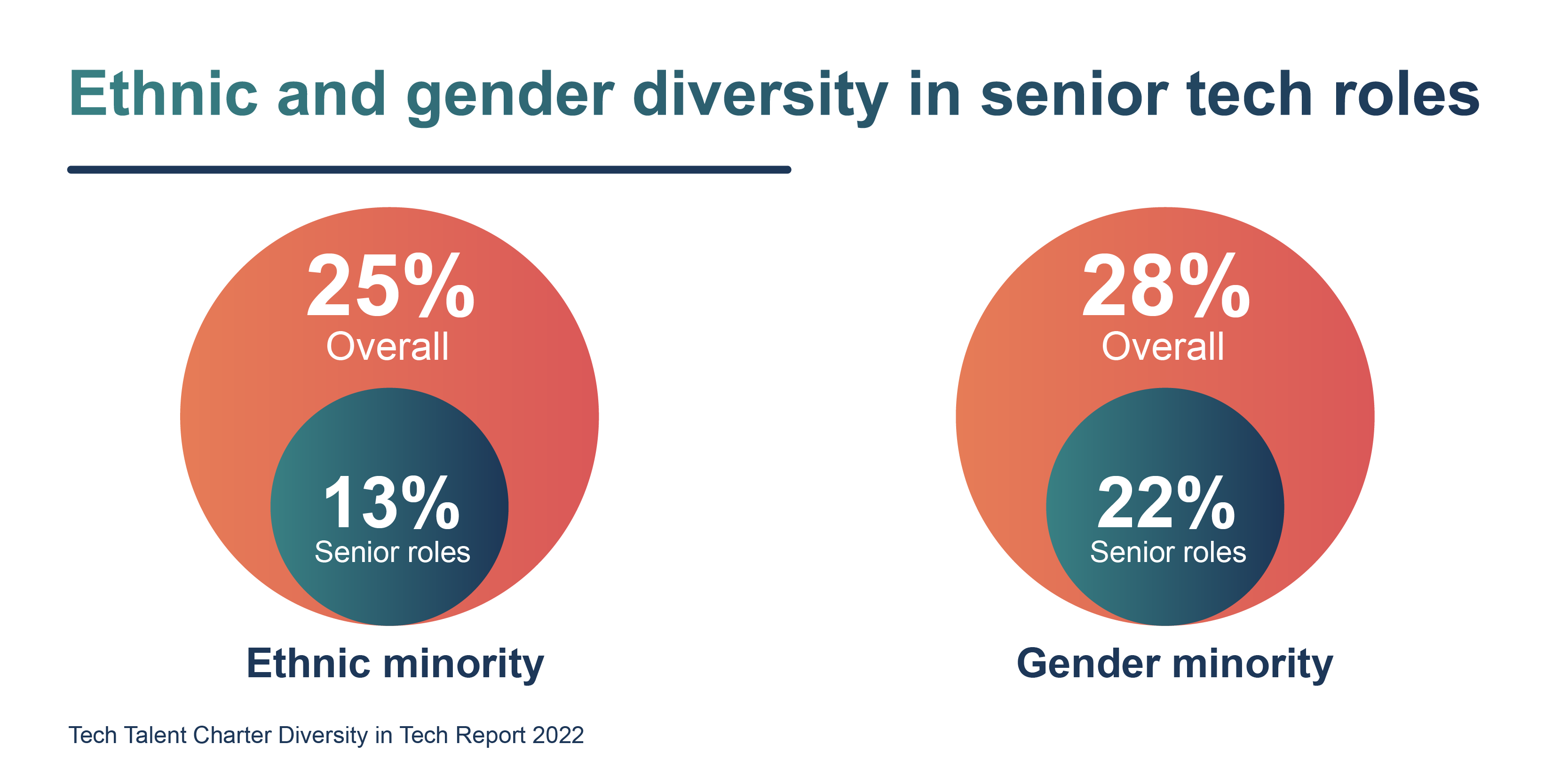
Disclosure rates and data gaps
The collection of diversity data and measurement within organisations is increasing across the board, however, data gaps persist with more commonality in certain areas. For example, whilst many of our Signatories’ tech employees provided their employer with ethnicity data, there was no ethnicity data for 36% of the sample. For 14% of tech workers, this was because their employer didn’t ask them to disclose their ethnicity data.
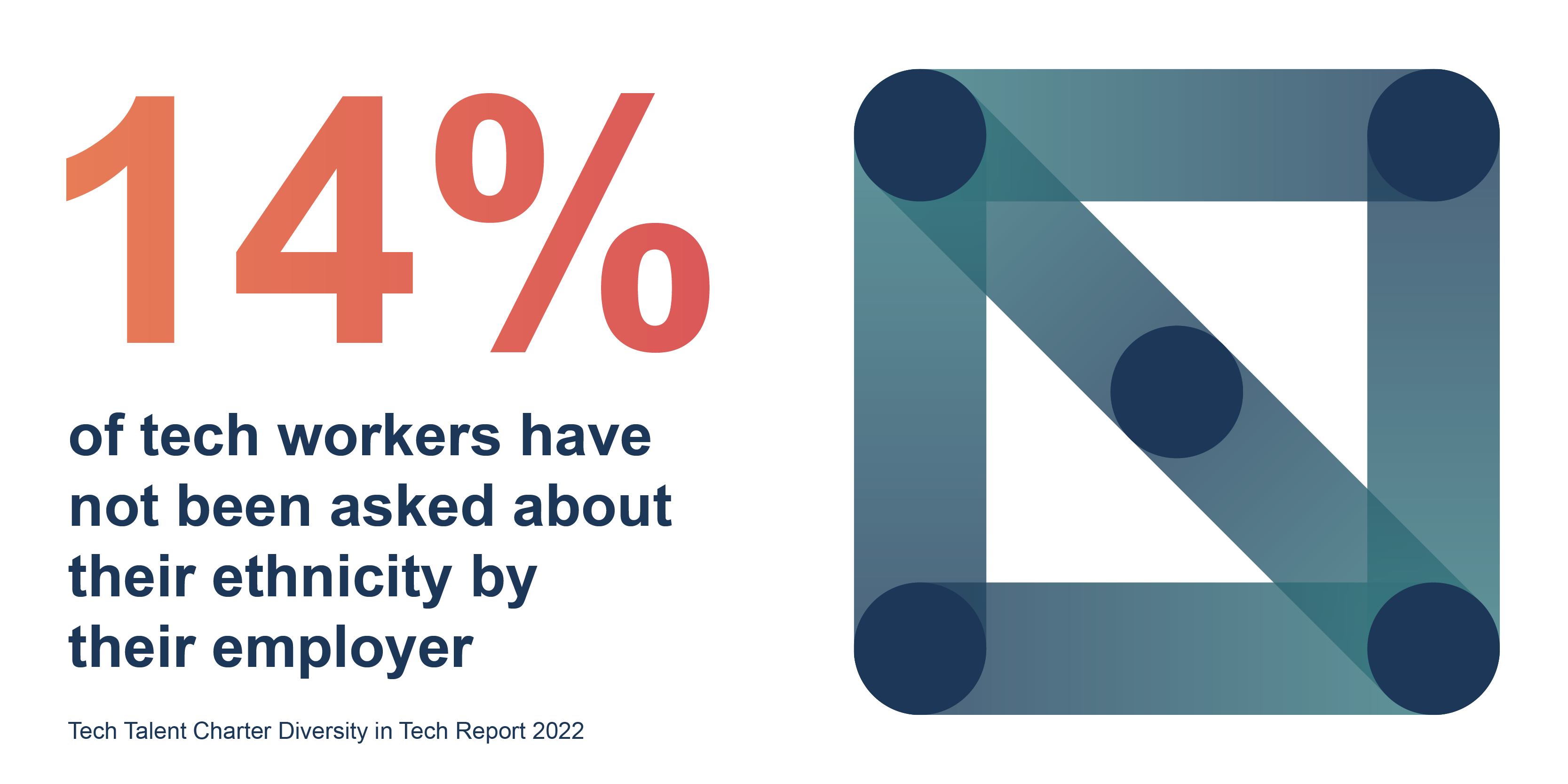
A further 3% of tech employees could not have their ethnicity data factored into our analysis because their employer’s policies around data and privacy currently prohibit participation in cross-company collaborative efforts or UK-specific data analysis. It’s important for all organisations to develop robust and trustworthy data and provide adequate privacy protections for their employees, in line with GDPR. However, low diversity and tech talent shortages are systemic issues that go beyond individual company boundaries and therefore, unless organisations engage in collaborative action to understand best practice and knowledge share, their success will be limited to a zero-sum game in which diverse tech talent is continually in short supply, more challenging to recruit and retain, or continually moving out of the tech sphere. Similarly, requiring all D&I data exercises to operate at a global level hinders the ability to identify localised challenges and solutions. Shying away from complex reporting may disguise discouraging metrics, but it ultimately inhibits progress.
For some organisations, the problem isn’t that they didn’t ask; it’s that when they do, their employees do not respond to requests for the information. In total, 16% of tech workers who were asked about their ethnicity declined to provide the information. This can of course be for many reasons, but employees preferring not to disclose can be due to concerns around how this sensitive data will be handled and whether it will have a negative impact to disclose such information. Organisations should pay close attention to the proportion of employees choosing not to disclose as this too can be a symptom of internal organisational challenges in this space.
“The collection of diversity data is challenging for many organisations, but this is further exacerbated when we take into account restrictive legislation in some parts of the world where it is not permissible to collect certain types of diversity data. In addition to this, different regions are often at different stages of their diversity journey, which for some means they haven’t yet begun the practice of diversity data collection. This can inadvertently create internal tensions within organisations between different regions and that can mean resources and energy are wasted on internal politics vs. on furthering an organisation’s aims and objectives in the diversity sphere.
At times, global data points serve as a smoky mirror to mask what is happening on a local level and employees can feel as though the relevance and positive benefit of initiatives and programmes seem far removed from their daily experiences in regional contexts. To truly create a holistic and informed picture of representation, organisations should strive to create some minimal global benchmarks of what will be measured, but this must not happen at the expense of simultaneously acknowledging the importance of local context and data to understand and tackle local issues in an informed and relevant way.”

Edleen John
“Within Technology & Digital at Global we believe if you can’t measure the problem, you can’t solve it. This aligns perfectly with TTC’s strategy to gather, analyse, and socialise DE&I data from across the Technology sector and provide us all with opportunities to reflect and grow. For us, being able to see how we compare to the rest of the industry and more importantly being able to make interventions to drive positive change is the reason we have and will continue to submit our data to TTC.”
David Henderson, Chief Technology and Product Officer at Global
“I passionately believe it’s important we capture the right data, and in the right way - it’s a key component to help drive our diversity, equity and inclusion (DEI) strategy. By anonymising data through collaborative data sharing, we’ll be able to accurately track where we have been on our DEI journey and where we are going. Having data can also help ensure driving DEI remains at the top of the business agenda. With more TTC signatories sharing their data, we all can benefit in having a substantial data-set that can be utilised to help examine the success of DEI strategies and shape future initiatives.”
Debbie Irish, Head of HR for UK and Ireland at HP

Should organisations expect 100% data disclosure?
Organisations are focused on increasing the disclosure rates amongst their employees regarding diversity characteristics, and it's undoubtedly the case that having a robust measure of diversity in the workplace is a critical part of making positive change. However, how much data is enough and is it right to aim for 100% data disclosure?
As minority groups can be represented in very small proportions within a workforce, aiming for high disclosure prevents entire minority groups from being disguised by what might appear to be a modest data gap. 100% data disclosure where all employees share their full identity characteristics is the ultimate positive outcome, because it provides a true organisational picture, whilst also suggesting a high level of trust and psychological safety in the organisation.
On the other hand, it’s possible to have 100% of employees respond to a D&I survey, but half of them tick the box that says “I prefer not to say”. This communicates very different information to a survey where fewer employees respond but all share their identity characteristics. Organisations need to remember to build trust with the entirety of their workforce when collecting D&I data, not just minorities, because concerns about sharing diversity information amongst majority groups can also lead to low disclosure.
Ultimately, it’s not just the completion rate of the D&I survey that’s the most important measure of success; it’s also the quality of the D&I information employees share and what the organisation does with it.
D&I data collection is about encouraging high quality responses, but we know many organisations are rightly very interested in whether their response rate is “normal”. Based on our Signatory responses, we therefore identified ethnicity data disclosure benchmarks by company size to enable organisations to contextualise how their disclosure rate compares to others. Armed with this information, organisations should ask themselves whether their emphasis needs to be focused on increasing disclosure rates, or increasing response quality.

.png)
Do you want to improve D&I disclosure rates?
Lexie Papaspyrou, COO at Tech Talent Charter, and Cat Wildman, CEO of Powered By Diversity, discuss practical guidance to improve D&I data disclosure and how to ensure D&I surveys deliver meaningful results.
Ethnicity: what are Signatories doing?
For the first time, alongside this data, we asked what organisations were doing to improve ethnic diversity and inclusion. The responses suggest the approach to this area is cautious and direct, with a more informational and educative tone. We found that employee networks or ERGs (Employee Resource Groups) were the most common activity, but ERGs had a much more dominant presence in ethnicity-focused D&I than they did for gender. There were also activities focused on awareness-raising and positioning of public messages, for example, joining pledge organisations and observing cultural moments of significance, such as Black History Month and Lunar New Year.
Making the pledge
There were two specific interventions that multiple organisations named individually in their ethnicity work. The first was to sign the Race At Work Charter by BITC. It requires organisations to make a series of commitments to improve ethnic and racial inclusion. With highly sought after job candidates commonly quizzing employers on their stance toward D&I in interviews, public pledges provide a way for organisations to share their values on the issue. Pledges also provide a safe and accessible starting point for organisations who are beginning their D&I journey, offering a basic set of principles they can use to scaffold their new D&I work.
The other intervention repeatedly referenced by Signatories was 10,000 Black Interns, which arranges internships for young black people. Given that the wider tech industry has fewer black tech workers than the overall workforce (although amongst TTC Signatories, Black representation is proportional to the wider workforce), it’s encouraging to see the level of engagement with this scheme. Especially as we also saw companies investing in D&I-focused progression programmes for ethnic minorities already in post.
Ultimately ethnicity-focused D&I interventions are about producing systemic and inclusion practices that permeate the entire culture of an organisation.
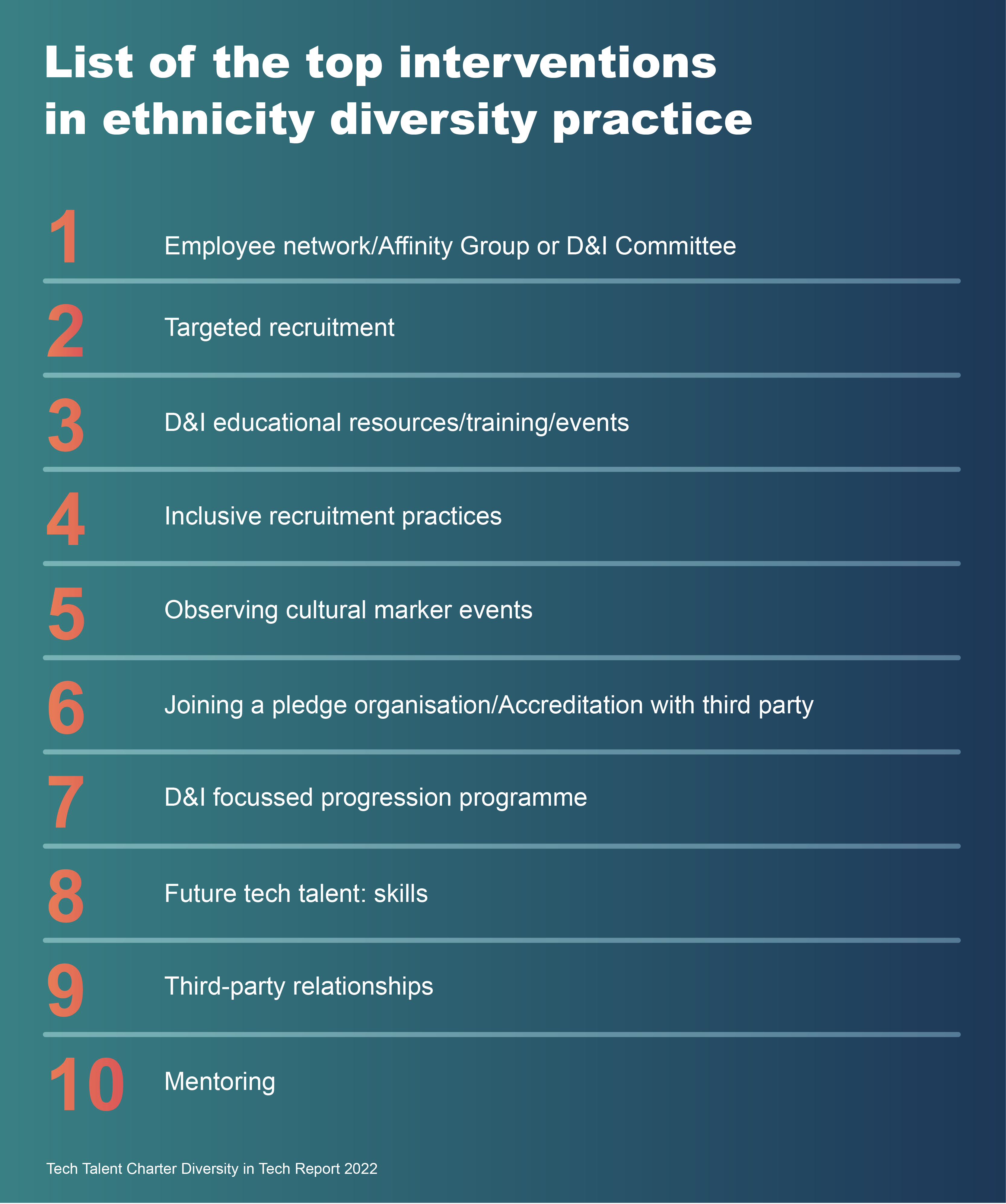
Embedding D&I for ethnicity and race through a large organisation - a case study from BT
What our Signatories are saying about…
Ethnicity
Northern Trust
BT
Here are some examples of innovative ideas in this area of practice:
1.
Emotional wellbeing support for colleagues affected by race-related events such as Covid-related racism, violence in the Middle East and the Ukraine war.
2.
Collaborations between different diversity networks to focus on intersectional lenses, for example partnerships between ethnicity-focussed networks and LGBTQ+ or Disability/Health networks.
3.
Defining an inclusive dress code policy that protects afro-textured hair and hairstyles linked to cultural, ethnic and racial identities.
4.
Education on how to speak about ethnicity and race at work, to help employees develop greater confidence and capability to engage in discussions on these topics.
5.
Targets for junior level hires from diverse ethnic backgrounds, and for promotions of ethnic minority employees to senior positions.
Prefer to read the PDF version of this report?
Joining the dots: ethnicity
There’s fantastic work going on in our Signatory base on ethnicity inclusion.
If you want to explore any of the ideas mentioned in this section here is the list of organisations, resources and partners our Signatories said they worked with on ethnic inclusion. You can also find a wealth of resources on ethnicity and race D&I practice in the TTC Open Playbook.

A pipeline to the top
If organisations wish to improve their diversity at the top of the pyramid, they need to ensure that the junior people they hire or train today have a clear, effective, and timely trajectory toward leadership, which must be coupled with adequate internal support structures and feedback. Establishing great diversity and inclusion practice early on sets up future tech leaders to understand the D&I business case, to have familiarity with what great diversity looks and feels like, and to ensure it is baked into every level of the organisation.
>50% of tech hiring managers have had direct experience interviewing, hiring or working with tech employees who gained their skills through a tech skills programme.
Training new tech talent
We asked Signatories whether they were running any career development initiatives designed to support D&I for new tech talent. 115 Signatories reported that they are providing tech skills programmes designed for people who are early in their tech careers, and from underrepresented backgrounds. These talent programmes were most commonly reported to be focused on people from socio-economically underprivileged backgrounds - around double those focused on gender and ethnic minorities. Programmes weren’t just targeted at young people either; there was also activity aimed at engaging older candidates in new careers through retraining programmes.

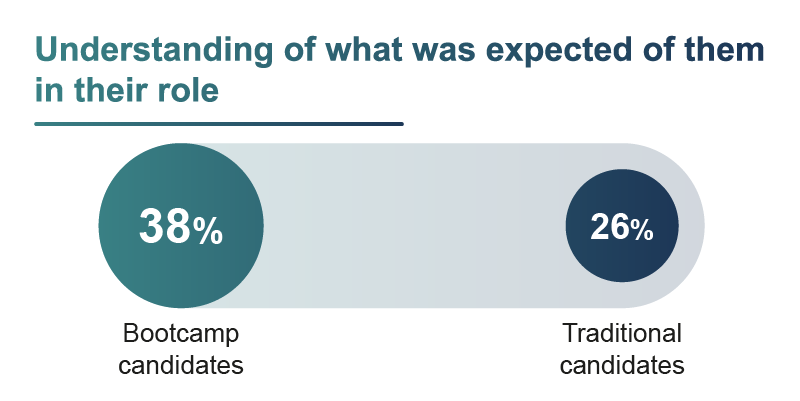
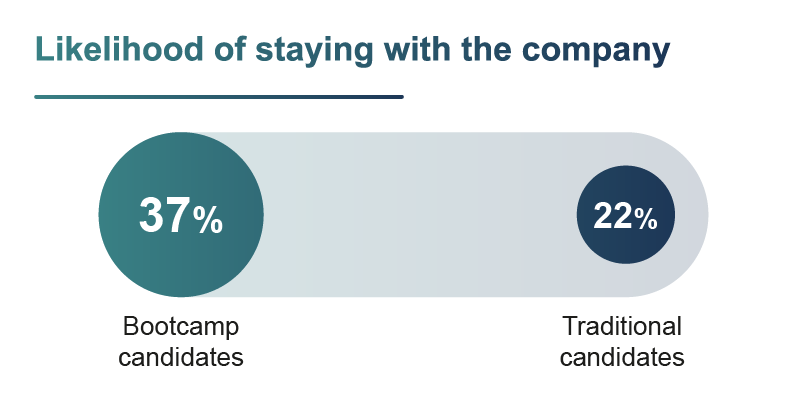
With investment in such tech skills initiatives, there is hope that tech talent will become both more available and more diverse in junior-level tech roles, particularly given how widely and well the talent from these programmes is being received by the tech industry. Our Routes to Tech study found that more than half of tech hiring managers have had direct experience interviewing, hiring or working with tech employees who gained their skills through a tech skills programme. Talent from these tech skills initiatives were also often regarded as highly as, or better than candidates from traditional career paths. Though news of tech layoffs have been widely publicised in the media, the tech skills crisis in the UK is still as potent as ever. Only by investing in new sources of skilled workers, will organisations be able to gain the upper hand in the war for talent.
“As new routes to tech develop, it’s important that employers, educators and partners work together to ensure new routes to tech careers are well designed, highly visible and supported by all stakeholders. The Tech Talent Charter has played a key role in drawing together stakeholders, including the Institute of Coding, to ensure that emerging routes to tech careers work for employers, learners and educators. That work is of vital importance as we work towards engagement with a larger, more inclusive and better trained digital workforce.”

Professor Rachid Hourizi, Director of the Institute of Coding
Developing experienced tech talent
In addition to many organisations investing in the entrypoint of the tech talent pipeline, we also saw many Signatories focusing on how to funnel more diverse talent toward senior positions and leadership teams through internal career progression initiatives. Of the 167 organisations who reported running a career development initiative designed to support better D&I, one quarter (25%) were focused at progressing minorities in the mid-level and senior levels of the business.
Programmes targeted at experienced mid-career employees, returners or high-potential employees from underrepresented backgrounds were all common approaches. These programmes typically featured networking, mentoring, coaching, and sponsorship activities. Other progression-focused initiatives included sharing career opportunities with those on parental leave and providing career support before, during, and after an extended break from work.
Signatories highlighted the need to scaffold career development initiatives together to form comprehensive and customisable career pathways, supported by strong inclusive policies. A piecemeal approach to career development activities might improve job mobility for the employee. However, without an inclusive company culture, it may result in career moves to another employer.
Whilst it’s great to see organisations investing in development of employees from underrepresented backgrounds, it's important to recognise that this is not the only factor that influences career progression. Companies also need to invest in training for managers, and a robust selection and progression processes. This balances the progression conversation between the performance of the employee and the fairness environment in which their performance is being appraised.
Career development is the antidote to attrition
Career development opportunities are crucial for talent strategy, especially at senior levels. But providing learning opportunities for employees addresses a related, and much wider problem, in the tech talent pipeline: attrition.
1 in 4 career development initiatives are aimed at mid and senior tech employees.
Typically, 80-90%+ of participants secure ongoing roles at a mid-to-senior level after a well-structured returnship.
- Women Returners
Not sure where to start on building a robust talent pipeline to the top?
Here are some examples from our Signatory base:
1.
Create managerial accountability for fair progression outcomes by measuring diversity in progression decisions.
2.
Provide practical manager training and support to help them advance the organisation’s D&I agenda in day-to-day activities.
3.
Implement fair work allocation policies that determine who gets client work and career-excelling opportunities.
5.
Establish a mentoring programme.
6.
Set up a sponsorship programme to champion and accelerate career development.
7.
Analyse the demographics of entry-level tech talent and provide lateral movement opportunities early on to develop skill in vertical functions with poor diversity.
Prefer to read the PDF version of this report?
What our Signatories are saying about…
Developing robust talent pipelines
Global
Direct Line Group
Flexible working
A key area of practice that underpins the inclusion debate for many groups is flexible working. In the year that saw 70 UK companies pilot a four-day work week and simultaneously maintain or increase productivity, there is more cause than ever to explore how flexible working can be leveraged for the mutual benefit of employees and businesses.
Across the board, research continues to show that a wider range of flexible working underpins inclusive work practice. In 2021, the Behavioural Insights Team ran a field trial with over 5.5 million job seekers and found that job ads advertising flexible working attracted up to 30% more candidates including higher proportions of women. When the benefits of flexible work on inclusion and productivity are so well-evidenced, the question for businesses is no longer why should you make flexible working available, but rather, how do you make it work for different roles, people, and career stages long term?
In the wake of massive shifts in work patterns following the pandemic and various counter movements to encourage workers back to the office, we surveyed Signatories to understand what flexible working arrangements they had in place and whether these were set to remain or be rolled back. Signatories are making multiple types of flexible working options available to their employees and in the overwhelming majority of cases, they reported that their flexible work arrangements were here to stay. This finding highlights the progressive role our Signatories play in moving work practices forward; sophisticated engagement with flexible working practices at Signatory organisations leads the overall market where only 30% of jobs are advertised as flexible.
Nearly half of the tech employees in our survey (47%) have the option for 100% remote working. A further 49% work at organisations where there is some remote working allowed with time, location or role restrictions, and 83% of tech employees work at places that offer condensed hours.
Job ads advertising flexible working attracted up to 30% more candidates
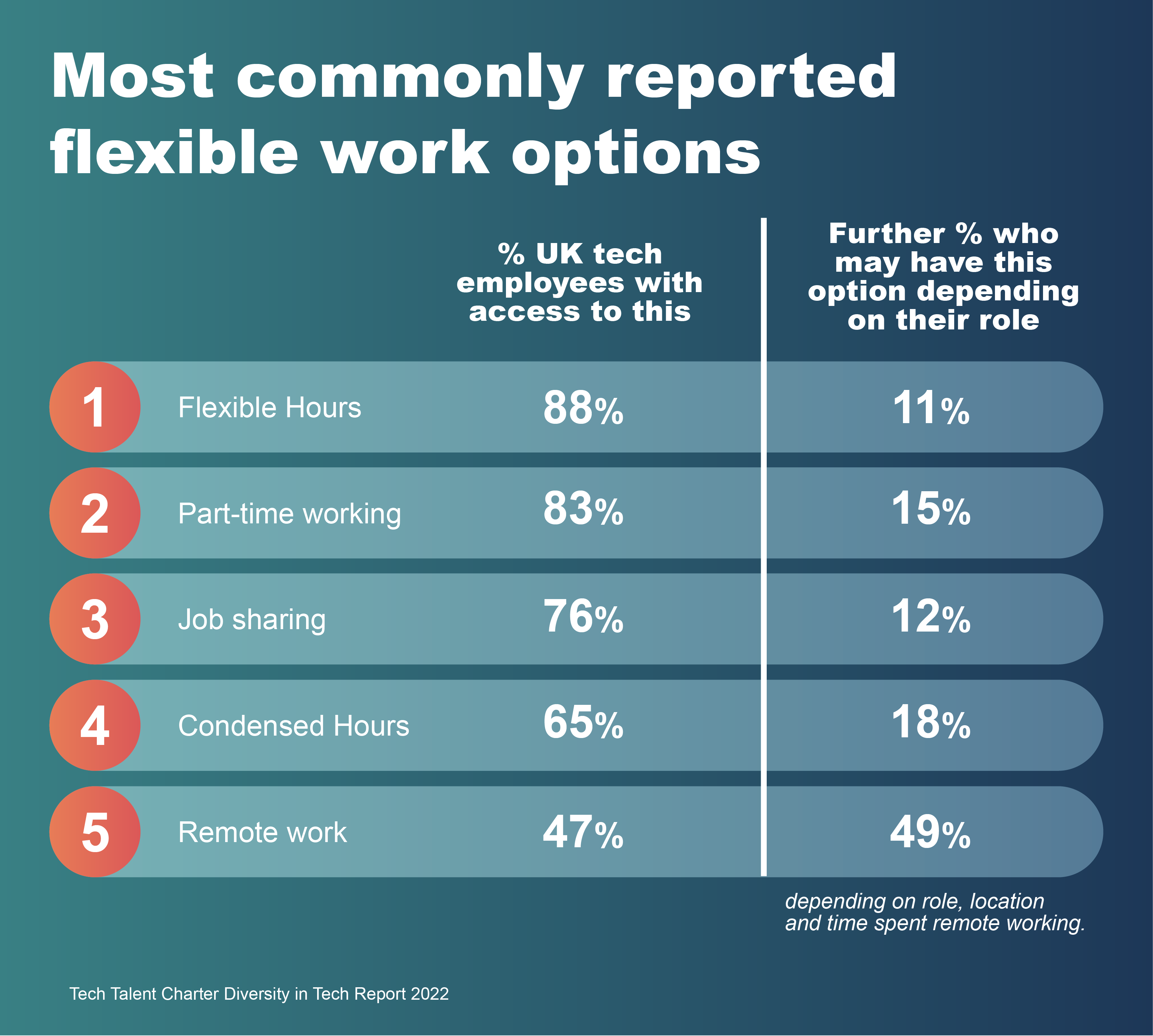
Nine in ten Signatory organisations state they offer part-time work to some extent. Just 2% of roles were at companies who do not offer any part-time work options at any level. The movement towards flexible work options by default is backed by a raft of recent legislation, codifying workers’ right to request flexibility from employers regularly, and from the outset of their employment. Whilst this is undoubtedly positive progress, it has sharpened focus on how well employers are enacting both the letter and the spirit of these laws. The right to request flexible working may be protected by law, but doing so may still carry a career cost if company culture disincentivises it. For example, ill-defined flexible work processes can result in a “don’t ask, don’t tell” approach to flexible working, where direct line managers permit it by exception on a case by case basis, but the practice is quietly disapproved of across the organisation. Research by Timewise backs this up; they found that part-time work is still stigmatised, less available in male-dominated industries, including IT, less available in senior roles, and less well-paid. Knowing that female IT specialists were almost five times more likely to be working part-time than males and more than two thirds of disabled people want flexible work, if organisations want to improve their D&I, it’s vital that meaningful flexible work is integrated into the entire tech talent pipeline.
Timewise’s research highlights that it’s not enough to make a vague statement that flexible work is available and expect all those who want it to make their case to the business individually. Rather, organisations need to actively offer the available flexible work options to all employees at every career stage in order to tackle pluralistic ignorance about flexible work. It’s also important to recognise that flexible work is a powerful factor that draws many individuals to retrain for the sector - indeed many undertake tech training in a flexible work setup. If flexible work options are only made available to tech employees at certain levels we may be setting up newly-trained tech workers to leave the sector before they have had a chance to make a start.
“Trying to attract diverse talent without offering flexible working is like going fishing without a net. Whilst we have made huge strides in how work is done post pandemic, and flexible working is far more acceptable, we can't assume its ‘job done’. To ensure diverse and inclusive workplaces, employers need to offer flexible working from day one; consider all forms of flexible working not just hybrid; and to make sure that their approach is inclusive and fair to all workers. Getting this right, and critically ensuring managers are trained and supported to do so, has enabled many of the organisations we’ve supported to both widen and diversify their talent pool, retain valuable employees who may need to balance work with health or care and build happier, more productive workplaces.”

Emma Stewart, CEO at Timewise
Bringing flexible working back into the office
The rapid spread of certain flexible working practices has not been without its critics or challenges, and there are some tough trade-offs yet to be made. Amidst the tech talent shortage, it’s critical that companies get early-in-career employees to develop their skills as fast as possible. Recent research by the Parliamentary Office of Science and Technology (POST) found that younger workers reported being less productive working from home. Some businesses expressed that whilst it’s fine for experienced professionals to move to a more remote work setup, greener hires lose the opportunity to cultivate necessary soft, tacit skills without in-person exposure to work environments, ultimately hindering their career development.

Other groups who could be disadvantaged by remote working are those who may, for many reasons, have a sub-optimal home-working environment. Issues here could be a lack of privacy, lack of workspace or office furniture, or an inability to create a distraction-free setting from other household members or dependents. Those experiencing socio-economic hardship may also face particular challenges with the cost of providing utilities and facilities typically provided by an employer at an office. At the most serious end of the scale are those who might be more at risk due to unsafe home environments - victims of domestic abuse, for example. Whichever of these issues employees are facing, layered on top of this will be the mental health stress of having these challenges exposed to colleagues over a video call.
However, there are as many cases for preserving remote working as there are for curtailing it. The same POST study found that disabled people reported being far more productive working from home. Remote work also makes a much wider array of jobs available to disabled workers than there would otherwise have been before work patterns changed. Remote work is also desirable amongst women and others who shoulder caring responsibilities alongside work. Given that gender diversity in senior roles is one of our Signatories’ top priorities, it seems obvious that flexible working is vital to increasing the numbers of women in tech overall and in senior positions. However, the POST research asserts a ‘flexibility stigma’ – a biassed attitude – towards remote workers, resulting in fewer learning opportunities and promotions for people in this group. With multiple conflicting priorities at play, including concerns over how the roll back of flexible working could discriminate against certain groups, many companies are struggling with the question of whether they should mandate employees back to the office, and if so, how?
Whilst there is no perfect pathway forward, considering the following ideas may help bring people back to the office successfully and inclusively.
“At Lloyds Banking Group we go beyond responding to requests and instead, are striving for flexibility as a default. We are working hard to create bold opportunities for our colleagues to work differently and revisit the way we work on a regular basis - to ensure it still works for individuals, the team and our customers.
Reduced hours, job sharing, hybrid working, shift patterns and split shifts are some common practices, but we aim to not limit what is available via a set list. Instead, we encourage our colleagues and managers to find ways of working that work for them, their team and their customers. Flexible working is available from day one and 96.3% of our job adverts promote flexible working (November 2022).”
Lloyds Banking Group
Ideas to help bring people back to the office successfully and inclusively
1.
Let employees choose the office days that work best for them. Having fixed office days can limit employees' ability to optimise the work environments they have at home, such as scheduling home working on days where household distractions are lowest.
2.
Set the expectation for the amount of time to be worked on-site as a proportion of employees’ contracts. Establish a “40% office, 60% home working balance” rather than “two days in the office per week”. Using a proportional system avoids penalising part-time employees.
3.
Create conditions that motivate employees to be in the office for a similar period of time. For example, we heard about an organisation that provides free lunches to all staff in the office the week before payday, which boosted office attendance naturally, especially amongst younger employees.
4.
When bringing teams together, set an equitable process for allocating physical resources, like desks and space, to allow part-time workers and people with specific needs to participate effectively.
5.
Provide training to managers on how to effectively manage remote and part-time employees and encourage managers to model good practices in working flexibly.
Prefer to read the PDF version of this report?
What our Signatories are saying about…
Flexible work
Timewise
PwC
FreeAgent
Oliver Wyman
Austin Fraser
Joining the dots: flexible work
There’s fantastic work going on in our Signatory base on flexible work.
If you want to explore any of the ideas mentioned in this section here is the list of organisations, resources and partners our Signatories said they worked with on ethnic inclusion. You can also find a wealth of resources on flexible working D&I practice in the TTC Open Playbook.

Social Mobility
Of all the D&I areas of practice we surveyed our Signatories on, one area was being measured significantly less than all others: socioeconomic background. Just 38% of Signatories are looking at data on social mobility. This was the only lens of diversity being measured by fewer than half of Signatories. Whilst social mobility might not appear to be a problem troubling the tech sector, a 2020 study by the Bridge Group found that the tech workforce is unrepresentative of the UK workforce with respect to socio-economic background. This discrepancy worsens in more senior roles and in certain specific tech occupations.
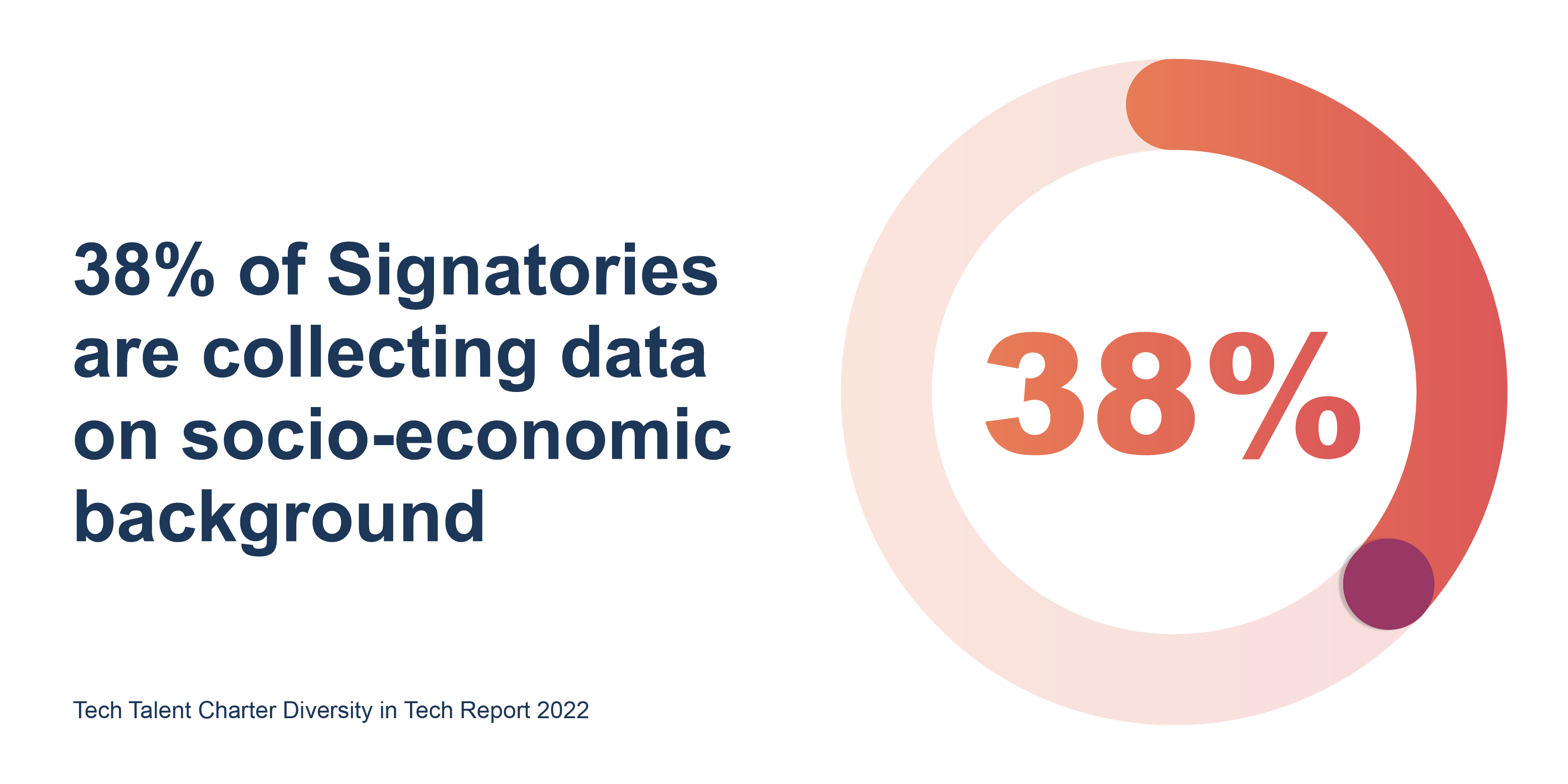
The natural champion of social mobility
Low social mobility comes at a high cost to the UK. Research by Oxera and The Times Education Commission found that increasing UK social mobility even modestly could increase annual GDP by £45bn. When you layer this on top of a shortage of tech talent, tapping into underemployed populations in social mobility cold spots is an obvious win for delivering economic and social value. The sheer demand for tech workers makes the tech economy a great vehicle for social mobility, because if you’ve got the skills, there are tech jobs out there for you that now pay around two and half times the average UK salary. Thanks to the prevalence of flexible working in tech, nearly half of these jobs can be done from any location. Remote tech jobs help to stem so-called “brain drain”, where skilled workers migrate to tech centres for work, further impoverishing regional economies and communities.
Some tech jobs pay around two and half times the average UK salary
“The tech sector should be fantastic for social mobility – valuing problem solving, innovative thinking and analytical skills much more highly than academic qualifications and wearing the right tie, and offering opportunities to design and products and services that serve the public and create solutions to big challenges. Unfortunately the evidence shows currently that highly educated people from professional backgrounds dominate skilled tech jobs in much the same way as they do more traditional professions like the law or banking.
Recruiting and retaining talented people and growing the right skills is critical for every business so if employers are recruiting only from a small pool, with some people and communities locked out altogether, that’s bad news for skills and productivity. Improving socioeconomic diversity in your business will mean you have people with a wider range of perspectives and backgrounds – avoiding groupthink and creating better problem solving. And tackling social mobility is often a great accelerator for race and gender diversity priorities as well.
The public increasingly expects business to act on social mobility – in part because of the heightened awareness of inequality as a result of the pandemic. Employers need to bridge the gap between education and the world of work, and make sure young people develop the skills they need for business, so it makes sense to invest in different pathways and recruit from the widest possible pool of talent. We know innovation thrives in diverse environments and teams with a range of perspectives are better at solving problems so making sure you have people from different backgrounds is essential. And the evidence shows this is vital for productivity too – lack of socioeconomic diversity at more senior levels means employees don’t reach their full potential.”
- Sarah Atkinson, CEO at Social Mobility Foundation
Putting aside the economic arguments though, the fact is, social mobility needs to be treated as a core issue for D&I practice in tech because, whilst it might not be a protected characteristic, it has a profound effect where it intersects with other protected characteristics, such as disability, age, ethnicity and orientation, as well as other factors like regional levelling up. Where organisations have focused interventions on social mobility their diversity levels were also higher across other areas. For example, the average proportion of ethnic minority tech employees was 6% higher at companies with interventions for social mobility compared to the TTC UK tech workforce as a whole.
The average proportion of ethnic minority tech employees was 6% higher at companies with interventions for social mobility compared to the TTC UK tech workforce as a whole.
Now you know, what next?
Knowing that there is so much to be gained by working on social mobility, companies may be asking how to get started: the key here is investment in tech skills and training initiatives that are designed to support people with less-privileged socio-economic backgrounds. Companies can do this by directly delivering training opportunities as part of their corporate social responsibility work. But if that’s not feasible, investment can also come in the form of sourcing talent from the training providers that are doing this. Encouragingly, many Signatories are doing just that.
Private tech bootcamps, apprenticeships, kickstarter programmes and employer-run tech skills offerings were all frequently mentioned as socially inclusive talent sources. The majority of tech roles do not require advanced computer science education, and tech employers often claim university students require further experiential learning to become proficient in a tech role anyway. Therefore, it makes sense to be investing in practical skills initiatives that deliver fast results for employers and learners alike.
Practical training also helps to address a challenge levied by many employers, that formal tech education struggles to match the pace of change in the tech industry; learners are coming out of high-quality formal education programmes, but their education is already out of date when they hit the ground. The agility and speed of new training models allows learning to be tailored to the skills employers need right now.
However, when making the choice of which programmes and schemes to work with, employers should carefully consider the social value of different economic models, as some are, surprisingly, not as socio-economically inclusive as others.
When free is expensive: economic models of tech training programmes
Despite their many strengths, non-academic tech training models still present challenges for socio-economic inclusion. Privately-run routes to tech provide fantastic opportunities such as close feeder relationships with multiple end-employers, soft skills training and pastoral support. However, the economic models of these offerings vary. Although many are free programmes, in the sense that the training provider does not charge the learner for their training, they require the learner to stop earning to undertake the training. This places economic strain and risk on the individual rather than the training company or employer, and ultimately excludes the people facing the greatest socio-economic hardship. “Free” may simply be too costly to be viable for those with dependents or without as much insulation to the economic environment.
Similarly, apprenticeships have experienced sharp drops in the number of starters both before and during the pandemic. The drop has been worse in areas of high deprivation than more affluent areas, and levels have still not recovered. Given that apprenticeships are one of the few routes to tech that provide paid training, this finding throws up questions about whether new routes to tech are truly helping those who need them most. In order to ensure that new tech training initiatives are truly having a positive social impact, both employers and providers need to enact these programmes authentically and intentionally, rather than just relying on the model to deliver for them.
Raising the game for routes to tech
TTC’s Routes to Tech research launched in October 2022 as a collaboration between thirty skills providers and end-employers, all intent on improving D&I whilst increasing the supply of tech talent in the ecosystem. Together they identified recommendations for both employers and tech training providers on how to optimise the success of new routes to tech.
Find out more about our Routes to tech research and the companies working with us on D&I in the tech skills pipeline.

What our Signatories are saying about…
Social Mobility
Code First Girls
techUK
Global
If you could only do one thing: technology capital
If your organisation isn’t in a position to focus on working with talent suppliers to improve access to tech careers, there is still research-backed action you can take to encourage more individuals from underrepresented backgrounds into tech. The notion of “technology capital” is well established and posits that it’s not necessarily who you know that facilitates access to the tech sector, but rather being aware of the landscape of tech roles and companies, and more generally, ‘how the sector works’. According to the Bridge Group’s research, when young people don’t know other people who work in tech, they tend to form impressions of what a tech career looks like based primarily on popular media depictions. This perpetuates a mistaken belief that the tech industry is reserved only for highly technical individual stereotypes rather than “people like me”. This is in spite of the fact that many young people reported they enjoyed technology, think computing is an important subject and are confident in their digital abilities.
Companies have a crucial role to play in correcting inaccurate perceptions of tech careers by reaching out to social mobility “cold spots” and providing contacts, inspiration and informative interactions with people who might not otherwise be aware that a tech career could be perfect for them. This activity not only supports social mobility but diversity across other lenses, such as gender. It can also be adapted to suit the resources of all company sizes and budgets. There are also third sector organisations that provide structure for this activity, such as Tech She Can and Stemettes.
Promoting technology capital in the community also delivers powerful benefits for employee engagement. Sharing and celebrating employees’ own stories helps build greater understanding and engagement internally as well as giving staff an opportunity to undertake meaningful and motivating work outside of their daily responsibilities. With so much to gain from such simple activity, improving “technology capital” is something that all organisations should be adding to their D&I practice.

Not sure where to start on social mobility?
Here are some practical examples from our Signatory base and D&I industry experts:
1.
Provide inspiring interactions between tech workers and young people in education. Reach out to future talent in social mobility “cold spots” to increase science and technology capital.
2.
Knowledge-share across the business what the criteria of socio-economic status are and why each measure is relevant.
3.
Invite employees to participate in anonymous disclosure of socio-economic background and explain why you’re asking for it, and how it fits into the organisation’s wider D&I strategy.
4.
Demystify tacit work assumptions: for example, if you’re taking a new colleague out for a coffee, make it clear whether or not the business is paying for the drink.
5.
Make sure internships are paid.
6.
Track socio-economic diversity at all levels of seniority.
7.
Nurture a culture of “no question too small”.
9.
Invest in non-traditional routes to tech, such as apprenticeships and tech bootcamps. Look for tech skills provisions with inclusive economic models for those who can’t afford to self-fund or lose earnings whilst training.
10.
Measure the socio-economic backgrounds of your team and senior employees to build a stronger evidence base. The Social Mobility Commission provides a fantastic Toolkit on what socio-economic background markers to ask about and how to interpret the data.
11.
Take ownership of offering up social mobility support policies: for example if your organisation pays transport costs for attending interviews, ask candidates directly whether they would like you to pay for travel, rather than putting the onus on the candidate to make the request.
12.
Remove recruitment requirements and information that disadvantage candidates from poorer socio-economic backgrounds. For example, remove requirements for elite university credentials; when using a blind hiring process, redact hobbies from CVs; use competency-based interview techniques to focus on skills over polish.
What our Signatories are saying about…
Social Mobility
PwC
Oliver Wyman
Nominet
Joining the dots: social mobility
There’s fantastic work going on in our Signatory base on social mobility.
If you want to explore any of the ideas mentioned in this section, here is the list of organisations and resources our Signatories said they worked with on social mobility. You can also find a wealth of resources on social mobility practice in the TTC Open Playbook.

According to Deloitte, 15-20% of the UK population is thought to be neurodiverse. Signatory activity in this area of practice suggests that Signatories are increasingly recognising the value neuroinclusion can bring to their talent planning and more than half of our Signatories (53%) are now measuring neurodivergence in their workforce - more than double the number who reported doing so last year.
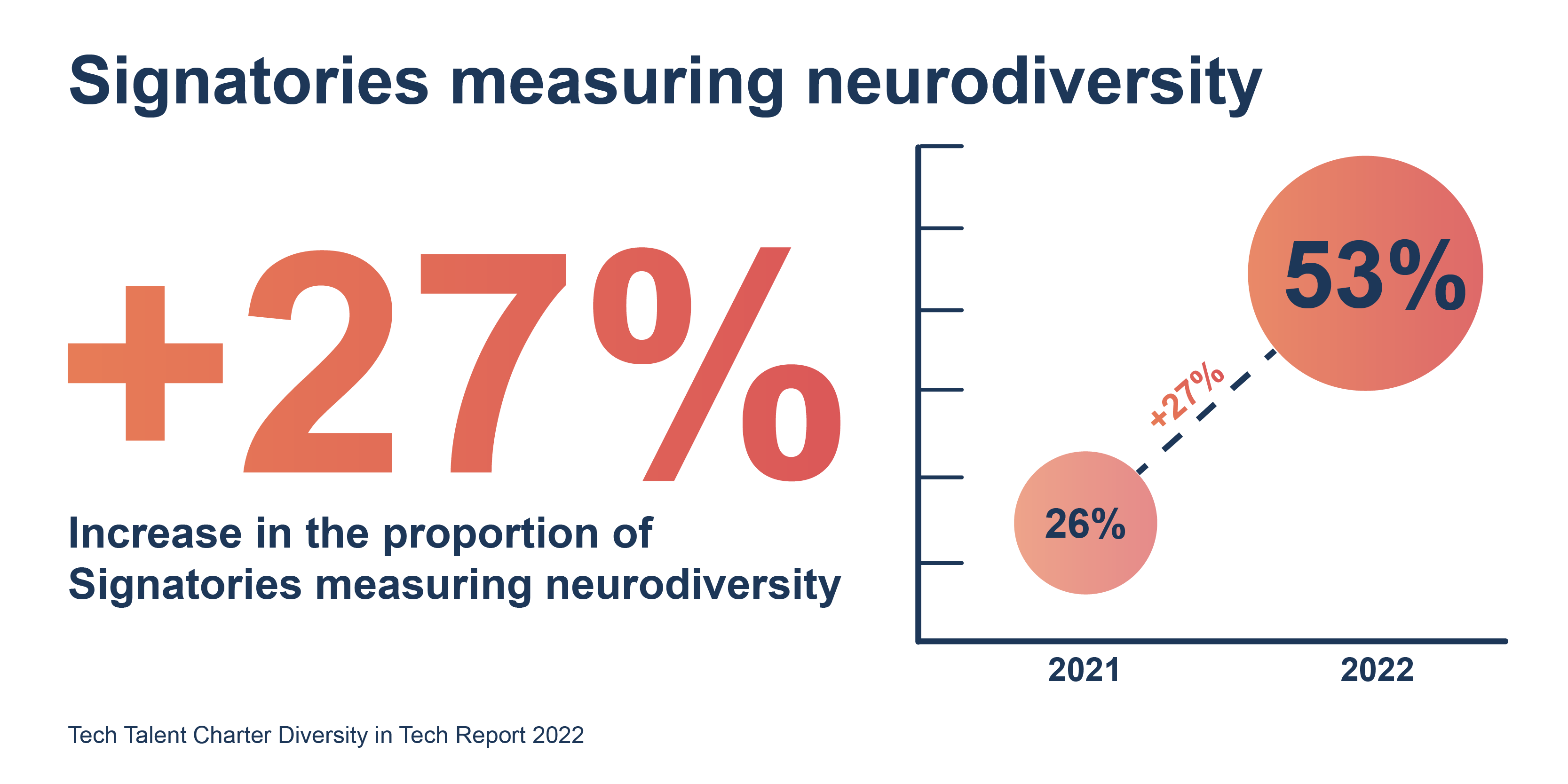
At its core, great neurodiversity practice requires organisations to create the flexibility for highly individualised, needs-led support without requiring formal diagnoses or standardised adjustments. Neurodivergent individuals can have the same neurotype but have different experiences and support needs. For example, a person with dyslexia can find one colour overlay helpful to their literacy, whilst another dyslexic person can find the same colour overlay hindering. Therefore it’s important that any neurodiversity practice has a person-centric approach.
The timing of increased awareness about neurodiversity, including the cognitive benefits conditions present, has synced with a growing talent shortage and skills gap. Leaders are beginning to understand there is a high population of unemployed potential they aren’t yet accessing that could add diverse thought and problem solving to their teams, which in turn will support innovation and growth.
Kirsty Cook, Global Director of Neuroinclusion at Auticon
Thinking differently about neurodiversity
Neurodivergent thinkers can display high skill in some competency areas coupled with challenges in other competency areas. The huge variability of challenges and strengths that neurodiverse people experience means it is crucial for organisations to facilitate an open conversation with individuals to understand what support will enable each individual to thrive. Neurodivergence has variously been described as a superpower or a disability, but individuals can identify differently to one, both or neither labels. The presence of impressive capabilities does not imply the absence of challenges and vice versa. Therefore it’s important to be guided by how an employee identifies, experiences and labels their neurotype, rather than how their neurotype presents or is perceived by others.
What our Signatories are saying about…
Neurodiversity
AbilityNet
Auticon
Cisco
Substrakt
Flexible neuroinclusive practice helps all employees, whether they identify as neurodiverse or not, to optimise their work environment. This is important because one of the biggest challenges in neuroinclusion is that diagnosis has historically been flawed. Most formally diagnosed neurodivergent individuals are diagnosed as children. However, diagnosis criteria have in many cases been based on a gendered presentation of neurodivergence modelled on males, leading to widespread missed diagnosis of neurodivergence in females, preventing them from securing the support they need. Therefore it’s important that formal diagnosis is not a prerequisite of intervention.
With improvements in research and awareness, more adults are being formally assessed as neurodivergent. However, new understanding of how it intersects with other characteristics, like gender, age and ethnicity is still emerging. For example, the onset of menopause can exacerbate the experience of ADHD, leading to the unmasking of neurodivergence at later career stages. Businesses need to be ready to support individuals' diagnosis journeys whenever they emerge and at any point during their careers.
Joining the dots: neurodiversity
There’s fantastic work going on in our Signatory base on neuroinclusion.
If you want to explore any of the ideas mentioned in this section, here is the list of organisations and resources our Signatories said they worked with on neuroinclusion. You can also find a wealth of resources on neurodiversity practice in the TTC Open Playbook.

Disability, health, and wellbeing
According to DWP, there are over 7.7 million disabled people of working age in the UK and they represent a massive pool of underemployed talent that could add tremendous value to the tech ecosystem. There is a strong business case for why organisations should endeavour to be disability inclusive: they are a source of untapped talent; they bring diversity of thought that reflects a significant group in the general population; and making adjustments to include them is typically extremely low-cost and straightforward. These factors, combined with the prevalence of flexible working and ever-improving assistive technology, make the tech sector a natural home for many disabled workers with digital skills.
Beyond the business case though, practically every single person in society will directly or indirectly be affected by permanent or temporary disability during their life. The improvements to products, services and jobs that better include disabled people, are the leading innovations for the wider market. They set the direction of progress and fairness in society, and nowhere is this more profound than with technology. In the case of disability, “doing well by doing good” starts at home, by understanding how disabled employees are valued, supported and empowered - a process that begins with measurement.
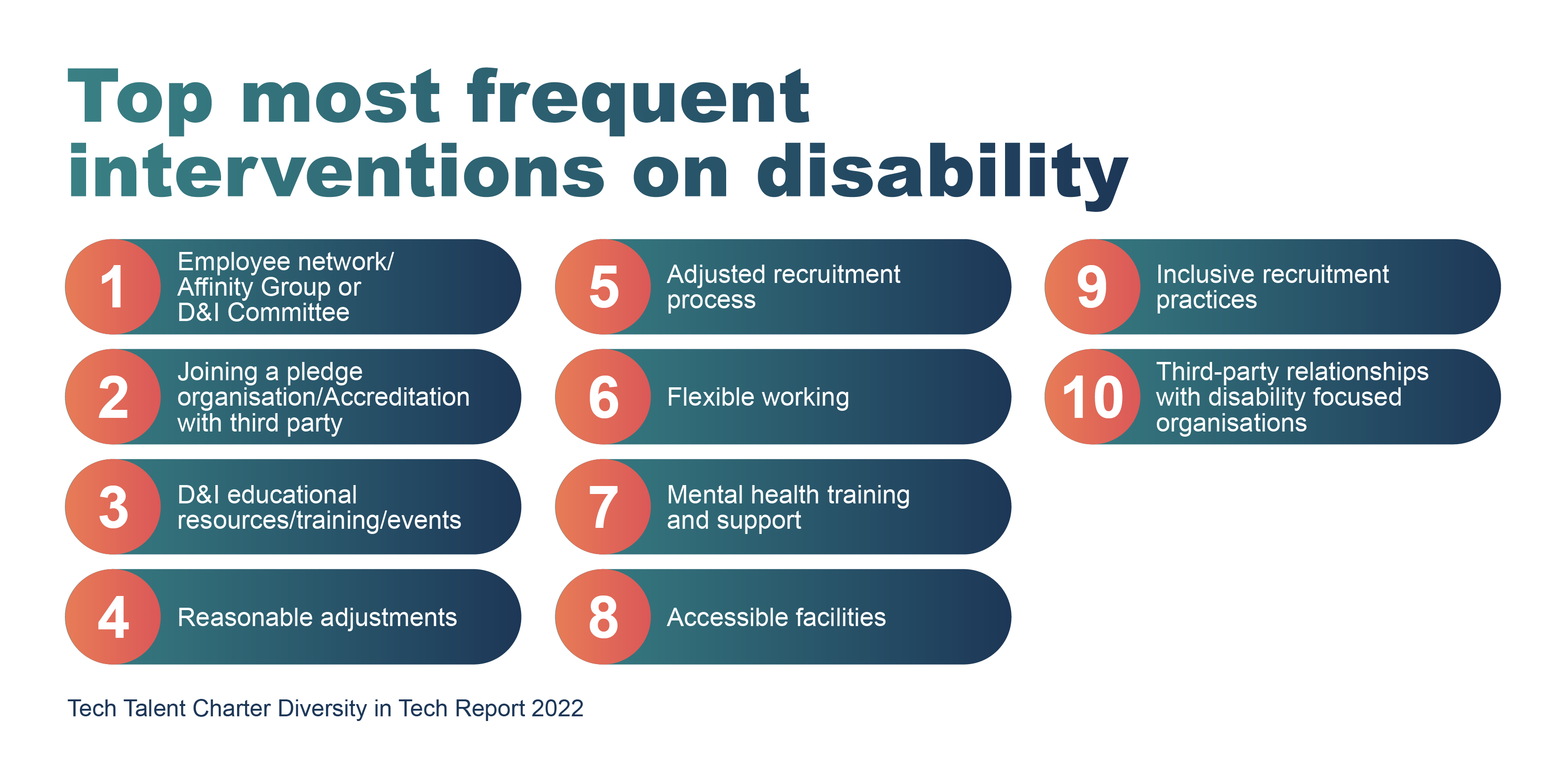
79% of Signatories reported that they are measuring disability diversity in their workforce - the fourth most common measure after gender, ethnicity and age. We asked Signatories what they do on disability inclusion and found that the most common activities were employee networks, recruitment and workplace adjustments, training and education for employees on disability-related issues, joining pledge organisations, obtaining accreditations, and flexible working.
As with neurodiversity, it’s important to take a needs-led approach to supporting disabled colleagues, rather than assuming what those needs are or what their limitations will be. This can involve things like asking a person whether they identify as disabled, and their preferred language to self-describe. It could also involve identifying the adjustments a person might need not only for their productivity, but also for their inclusion in the culture of the organisation. For example, hardware adjustments for productivity can be a specialist keyboard, but culturally could also be an adapted kitchen tray that allows a disabled person to participate in the unofficial office tea and coffee rota. We also need to ensure we frame conversations in terms of disabled colleagues’ achievements and strengths rather than just the adjustments to accommodate challenges. When we add these approaches together we can enable disabled colleagues to be included in both the direct and tacit messaging they receive.
What our Signatories are saying about…
Disability inclusion
Lloyds Banking Group
Deloitte
BT Group
Disability Confident
A wide spread of Signatories reported accreditations and pledges, with 50 Signatories referencing their accreditation on the Disability Confident scheme in their response. Creating a consistent and widely recognised standard of practice on disability inclusion is undoubtedly a victory for the scheme. The scheme also helps prospective talent identify future employers who have invested in disability inclusive practices.
However, being accredited may also generate complacency and a tick-box mentality if organisations are only following the letter of the criteria for the accreditation, rather than the spirit of the scheme itself.
“Disability Confident is a useful scheme to get organisations reflecting and taking steps to create a more accessible and inclusive working environment for their future and current staff. It also signals to candidates that their needs are likely to have been considered and the employer will positively approach a discussion about what they need to work at their best. This is increasingly important with working age people living with disabilities on the rise and also a broader cultural shift where job candidates are seeking an organisation that shares their values of inclusion when making a decision about where they want to work.
Where the scheme can fall down is when there is a tokenistic approach to demonstrating the organisation’s accessible, inclusive practices. Many organisations place their focus on adapting the recruitment process and fail to address structural issues relating to ways of working that disadvantage disabled employees. Taking a robust approach to this is useful and AbilityNet provide free training to help organisations break this down across the employee journey”
- Amy Low, Service Delivery Manager at AbilityNet
They also highlighted the need to demonstrate what inclusive methodology looks like for organisations of varying sizes and means, as smaller organisations may struggle to meet the scheme criteria due to the sheer volume of work involved, despite SMEs being some of the organisations doing highly valuable grassroots work with disabled employees.
Ultimately, joining a scheme like Disability Confident could be hugely valuable for organisations to signal their values and to provide structure to their disability inclusion practice. But it’s important to recognise that there is no shortcut to meaningful D&I practice and that what companies put into the scheme is what they will get out.
Mental health and wellbeing
A burgeoning area of disability inclusion practice was the mention of mental health and wellbeing activity. Men’s mental health has often been at the centre of public awareness on this topic, especially in light of the oft-cited statistic that suicide is the leading cause of death in men under the age of 50. But research released in 2022 by Covid Social Mobility Opportunities (COSMO) adds new and wider context to the issue. It found that nearly half of young people now experience mental health problems, up by a quarter compared to five years earlier. The same study found that mental health presented a stark challenge for those who identified as non-binary, that women experience worse mental health than men, mental health issues affected those of multi-ethnic and White ethnic groups more than other ethnicities, and mental health was worse amongst those with caring responsibilities compared to those without.
With this generation of future talent about to join the working-age population, it’s essential that businesses prepare to support an intergenerational workforce where large groups face generationally specific mental health challenges. Organisations were split as to whether they classified mental health and well-being as part of their disability practice or as its own area of work. However, where specific effort on mental health was mentioned, activity included the following.
Research released by COSMO found that nearly half of young people now experience mental health problems
The number is up by a quarter compared to five years earlier.
Where Signatories mentioned specific efforts on mental health, it included the following:
1.
Mental health/wellbeing champions or allies who are trained in mental health first aid.
2.
Mental health training for line managers, that includes recognising when to escalate to health professionals.
3.
Employee Assistance programmes.
4.
Recharge days where the organisations closes down entire regions for the day to give all colleagues a protected break from work to recharge and refresh.
5.
Providing access to tools and services that support mental wellbeing, such as mindfulness meditation apps and wellbeing platforms like the wellbeing platform, Frog and Headspace.
6.
Marking and raising awareness of initiatives such as Movember, Anti-bullying week, Time to Talk Day, Mental Health Awareness Week, Stress Awareness Month.
7.
Discretionary days off to support mental health and wellbeing without needing to disclose the reason.
8.
More nuanced and flexible bereavement policies to support wider types of emotional loss, beyond a parent, child or spouse, such as the loss of a pet.
9.
A well-being passport that documents and agrees the needs, adjustments and preferences for individual employees. The passport travels with the employee through their time at a company, facilitating transitions of line management.
What our Signatories are saying about…
Disability inclusion, health and wellbeing
Three UK
AbilityNet
Joining the dots: disability inclusion, health and wellbeing
There’s fantastic work going on in our Signatory base on disability inclusion, health and wellbeing.
If you want to explore any of the ideas mentioned in this section, here is the list of organisations and resources our Signatories said they worked with on these topics. You can also find a wealth of resources on disability inclusion practice in the TTC Open Playbook. You can also watch our Share and Learn session on Disability Inclusive workspaces on Youtube.

LGBTQ+ inclusion
LGBTQ+ inclusion
Based on the 2020 census, ONS estimates that 3.1% of the UK population (aged 16+) identifies as gay, lesbian or bisexual. As a society, we have made progress on orientation-related issues, with the census 2021 asking about orientation and, for the first time, transgender identity. With recently published ONS analysis of gender identity and orientation data, we are now better placed than ever to understand the picture of inclusion for the LGBTQ+ community. And over half of our Signatories - 66% - now collect employee data on orientation; compared to our survey last year, this is 22 points higher. Yet, LGBTQ+ inclusion in tech remains a significant problem area.
Left out for staying out
According to 2018 research, 1 in 3 people in the LGBTQ+ community who had previously come out, decided to reverse being open about their orientation after starting their first job. And this is more pronounced in junior employees (41%) compared to senior employees. McKinsey reports that women are far less likely to be out (58%) compared to men (80%). If we are to create inclusive workplaces where employees can thrive, we need to ensure they feel comfortable being their authentic selves without the burden of continually correcting assumptions about their identity or only feeling safe enough to bring their full selves to work once they have already “made it”. This speaks to a serious and pervasive issue with inclusion more broadly. So despite a general trend toward greater LGBTQ+ inclusion in society, workplaces may not yet be as inclusive as employers might think. Yet there are positive steps being taken.
According to our survey results, a key focus area for many organisations is building team understanding and awareness of LGBTQ+ issues. Signatories most frequently reported having Employee Resource Groups and networks in support of this inclusion area. The activity was also frequently mentioned in reference to awareness raising events, with PRIDE being celebrated by many organisations. However, there were also organisations who were going beyond this to embed LGBTQ+ inclusion into their wider systems and processes.
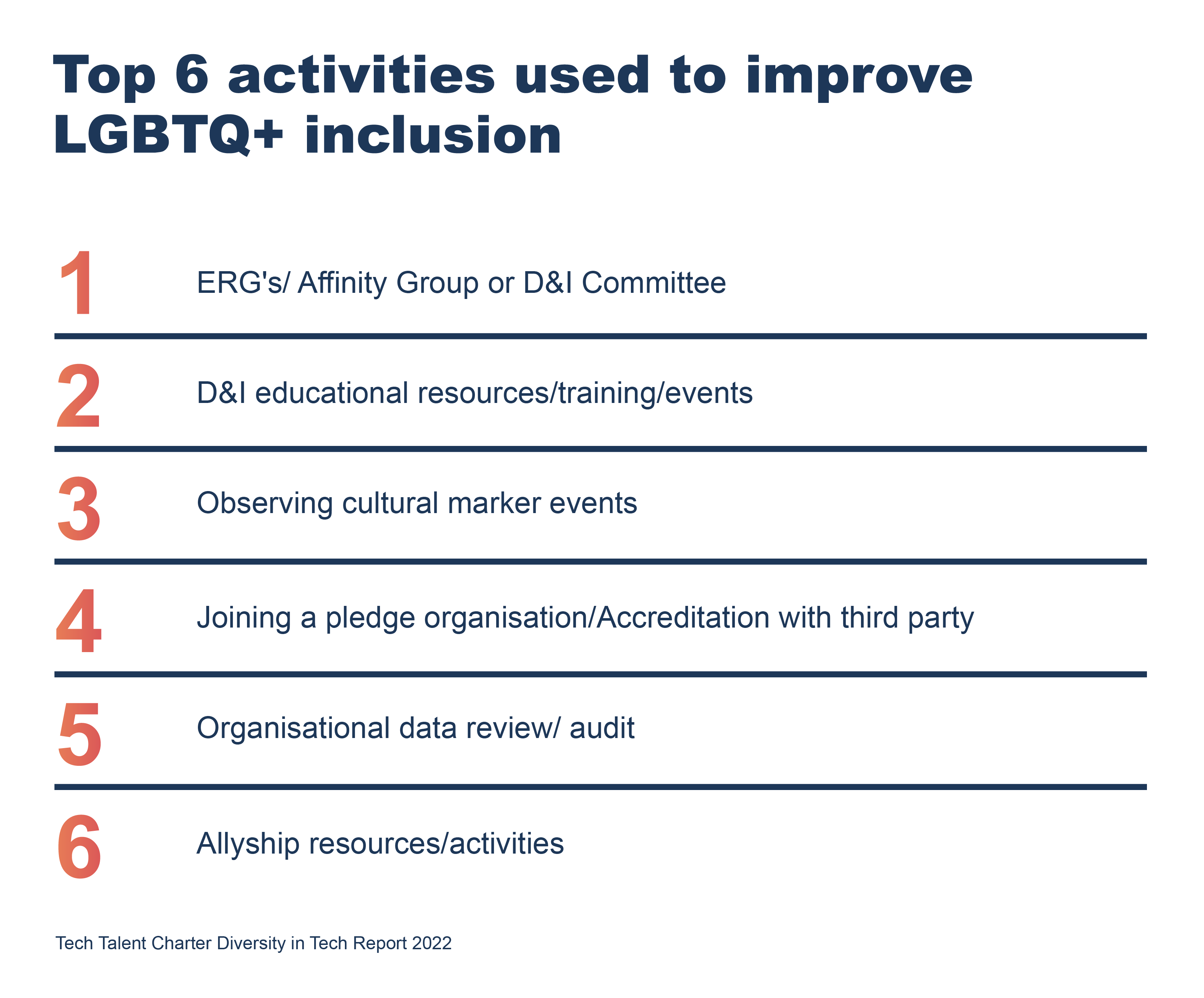
Join over 700 organisations and become a Signatory of Tech Talent Charter
Some of the LGBTQ+ inclusion practices our Signatories reported included:
1.
Measuring transgender and non-binary gender diversity, not just men/women.
2.
Options to use the gender-neutral title “Mx” in business systems.
3.
Healthcare benefits to support employees who are transitioning.
4.
Investing in “Pride allies”, who are trained, informed and have responsibility for being visible and vocal advocates for LGBTQ+ inclusion within the business.
5.
Marking other moments of awareness such as International Day Against Homophobia, Transphobia and Biphobia.
6.
Adapting the language and content of family policies to be inclusive of same-sex couples.
7.
Having a gender expression and transition policy.
8.
Gender-neutral and accessible toilets.
What our Signatories are saying about…
LGBTQ+ inclusion
Lloyds Banking Group
Three UK
Flutter
Accenture
Joining the dots: LGBTQ+ inclusion
There’s fantastic work going on in our Signatory base on LGBTQ+ inclusion.
If you want to explore any of the ideas mentioned in this section, here is the list of organisations and resources our Signatories said they worked with on LGBTQ+ inclusion. You can also find a wealth of resources on neurodiversity practice in the TTC Open Playbook.

Age
When we talk about common tech worker stereotypes, gender, ethnicity and neurodivergence will often arise. However, there is one protected characteristic that sees far less air time in the D&I debate, even though it also carries a potent stereotype: age. The stereotype that older people lack tech-savvy is highly pervasive, even in business environments where great D&I practices exist.
Worryingly the tech industry seems to offer a particularly harsh experience on this front compared to other industries. A 2019 survey by CWJobs found that the average UK tech worker starts experiencing ageism at the tender age of 29 - nearly ten years earlier than the national average. And by the time tech workers reach their late thirties, a third say they are worried about losing their job due to their age.
Experts have posited many reasons why the tech sector leans toward younger workers. Factors such as higher costs of hiring and retaining experienced talent during the economic downturn; the willingness of younger workers to take lower salaries combined with equity; younger tech recruiters unconsciously preferencing people of a similar age to themselves; and the cultural rub of older employees reporting to younger bosses, have all been raised as part of the issue.
In light of these problems, we asked our Signatories whether they measured age or generational differences in their workforce, and what they do to support D&I from this lens. We found that data on employee age was the third most common type of diversity data Signatories collected after gender and ethnicity. 89% of our Signatories reported that they collected this information. However, just 35% reported they were actually undertaking any work to improve age or generational diversity.
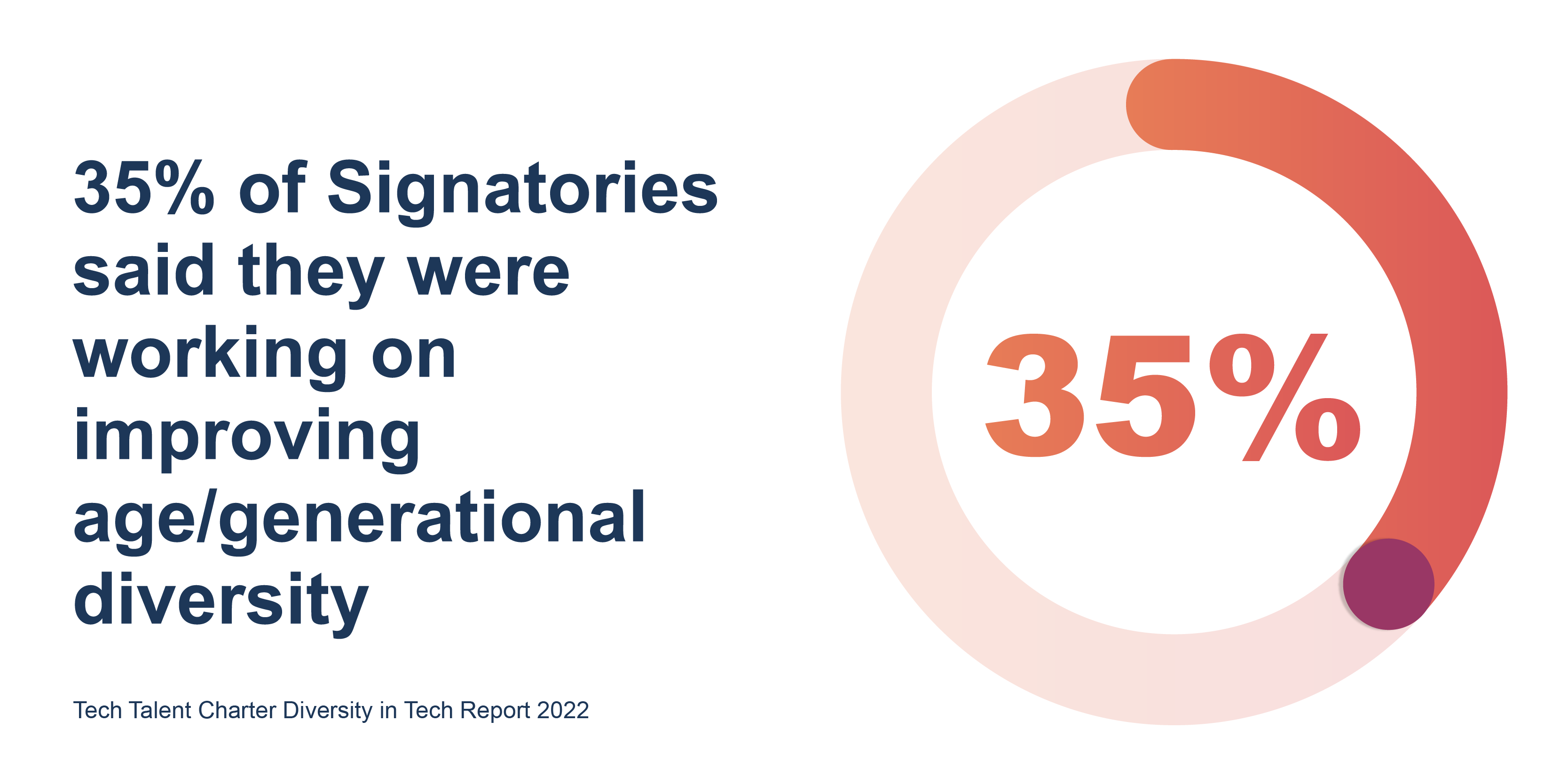

Those who did invest in this area cited Grandparents’ leave, and “Planning for Retirement” workshops. Larger organisations also reported benefits packages designed to appeal to employees at different life stages, such as life insurance, enhanced pension plans and critical illness cover. Signatories also highlighted reverse mentoring programmes as mutually beneficial development opportunities for staff in different life and career stages. From a recruitment perspective, Signatories reported working with the parent-focused employment sites Working Mums and Working Dads, and Working Wise - an employment site targeting talent in the over-fifties age category.
General reflections on D&I and hot issues like gender and ethnicity make it easy to forget that the two hardest-hit age groups of the pandemic for long-term furlough and unemployment were the over-fifties and the under-twenty fives. As social debates increasingly draw battle lines along generational divides, it may be time for organisations to reawaken their focus on this lens of D&I practice, not only as a hidden-in-plain-sight talent source, but also as a powerful backdrop against which the coming decade’s defining moments will play out.
What our Signatories are saying about…
Age and generational D&I
Booking.com
Captify
Haymarket
Credera
Lloyds Banking Group (LBG)
Joining the dots: age and generational D&I
Does your organisation do great work on age and generational inclusion practice that could help other organisations excel in their efforts in this area?
Get in touch or send us your Signatory Spotlight!

Religion
Of all the protected characteristics we asked about, religion or deeply-held belief had the fewest responses from Signatories. Although there was little specific action reported, belief-based inclusion is supported by a number of “lowered-curb” practices that may not be directly targeted at faith-based inclusion but still ultimately provide benefits. For example, flexible hours and bank holidays enable employees to schedule holiday leave or weekly worship around the religious and cultural festivals that matter to them.
Though there were few mentions of third-party organisations that support our Signatories with religion and belief-based inclusion, two were mentioned:
https://wudumate.com/
https://faithbeliefforum.org/
Religious inclusion is generally well-understood and established in UK business environments. However, in the year that the Census found fewer than 50% of the population to be Christian for the first time in its history, this may be a moment to revisit and reflect on the need to help employees of all faiths feel included and valued. Especially in an era when faith-related news is highly politicised and often tilts toward negative narratives. Now may be a moment to embrace and support colleagues of various beliefs more so than before.
Where respondents reported detailed D&I practices, they included:
1.
ERGs and networks for employees of various faith groups, including networks for specific religions and interfaith networks.
2.
Raising awareness of different faiths and belief systems, and explaining the significance of certain religious dates and how they are observed.
3.
Celebrating religious occasions not already marked by UK public holidays, such as Diwali, Vaisakhi, Eid, Ramadan, Chinese New Year, Holi and Hanukkah.
4.
Providing dedicated contemplation, prayer and reflection spaces for staff.
5.
Where employers provide meals to employees, offering different dietary options to include staff with belief-based dietary requirements.
6.
Providing Wudu ablution facilities on site.
7.
Guidance and policies to support colleagues during religious fasting periods, such as reducing the workday by two hours and sharing best practice when mixing non-fasting and fasting colleagues in communal spaces.
8.
Consider faith-based perspectives when planning work-related social activities, such as all social events including alcohol, or falling on a certain day when specific religious groups may not be able to participate.
What our Signatories are saying about…
Religion
Flutter
Oliver Wyman
Deloitte
Direct Line Group
Joining the dots: religion
We’d like to be able to offer more insight to our Signatory base on what they can do to improve their religious inclusion practices.
Does your organisation do great work on religious inclusion practice that could help other organisations excel in their efforts in this area? Get in touch or send us your Signatory Spotlight!

A core feature of D&I practice is that organisations must have a plan to effect change.
Through our annual Signatory surveys, we identified a set of foundational inclusive practices emerging across the board, that support inclusion across many diversity lenses and could be enacted irrespective of team size or budget.
We have also collated practices that feature in organisations that are leading the field with their D&I practice.

The UK tech ecosystem is the natural home of innovation, in both technology and people practices. If we can successfully pursue the interdependent goals of D&I in tech, and a highly-skilled tech workforce, we could turbo-charge economic growth and opportunity for all. In this report we can see three overarching areas of action organisations need to be focusing on.
We must redouble our efforts to train, reskill and upskill people in the expertise our tech economy needs. To support Signatories with these efforts, TTC will continue to develop our Routes to Tech work, mapping out tech career pathways, offering research insights, and amplifying the recruitment opportunities tech skills providers can bring to employers and future tech talent.
Second, we must double down on improving retention, employee development and promotion, by defining new policies and trialling new initiatives where they are needed, and investing in inclusive culture. By tackling the persistent barriers in the pipeline to the top, we can stem the loss of highly-sought-after experienced tech talent.
Finally, we need to acknowledge that there is a powerful raft of evidence-backed, widely-used practices that benefit employees across the board. Through our survey we can show these “lowered-curb” practices to be a newly-established expectation that all organisations should be aiming for, to drive for better inclusion, attraction and retention.
These key learnings, along with all the insights generated through our survey, will inform the TTC’s work, as we continue to support our Signatories and the wider tech economy with their D&I, tech talent and skills efforts. The only way we can collectively maintain our tentative and promising progress is if organisations recommit to collaborative action. By collecting and sharing insights with TTC, we enable the entire tech ecosystem to learn about what works, develop our collective talent pipeline, and grow the digital economy.
There’s still much work to be done and many lessons to learn in the D&I space. It is energising to see progress and decisive action from our Signatories in the areas of most promise and greatest need. We hope that through continued collective action, we can drive greater inclusion across society and see the UK tech economy further cement itself as a global leader of innovation. Summarised again below, are our key findings.

Join over 700 organisations and become a Signatory of Tech Talent Charter
TL;DR
1.
The sophistication with which organisations collect D&I data is growing, which is a good thing. However, it’s also creating challenges for measuring D&I across the ecosystem as companies grapple with ethical and privacy considerations around D&I data.
2.
Ethnic diversity amongst tech employees is strong, with 25% belonging to ethnic minority groups. The representation of individual ethnic minority groups is also inline or better than the national average.
3.
Work on LGBTQ+ inclusion has moved beyond awareness raising and companies are working to codify LGBTQ+ inclusion into their policies and benefits for example with transitioning policies and family policies that support same-sex couples.
4.
Diversity in senior roles is a challenge. Gender minorities are 6% lower in senior roles than tech roles overall, and concerningly, ethnic diversity almost halves in senior roles from 25% to 13%.
5.
25% of Signatories who offer career development programmes aimed at improving D&I have programmes aimed specifically at middle and senior level employees.
6.
Reproductive health issues such as menopause and fertility are areas of hot activity for many organisations, especially in relation to gender, age and LGBTQ+ inclusion.
7.
Employee Resource Groups are one of most prevalent forms of D&I activity for a number of areas of practice and the sophistication of these networks varies greatly.
8.
Disclosure rates for ethnicity are around 86% for medium sized organisations (50-249 employees) and 76% - 82% for larger organisations.
9.
Neurodiversity emerged as a distinct area of interest with the number of organisations measuring it doubling to 53% compared to last year.
10.
Measurement and practices to support social mobility lags behind other areas of D&I practice and this needs to change.
11.
Activities around disability show mental health and wellbeing as a particular area of focus for many organisations.
12.
Measurement of non-binary genders is low with only 35% of companies asking about non-binary genders.
13.
28% of tech workers are gender minorities, marginally higher than past years.
14.
Flexible work options are widely available for tech employees.
About Tech Talent Charter
The TTC is an open industry collective taking action on these, and many other D&I issues. To learn more about any of the points covered in this report and work collaboratively with the other organisations who are leading in this space, please visit www.techtalentcharter.co.uk where you will find free D&I resources, including information about the TTC.
Thank you
This report was made possible thanks to the generous support of many organisations and individuals. Many thanks to our sponsors.
Principal Partners
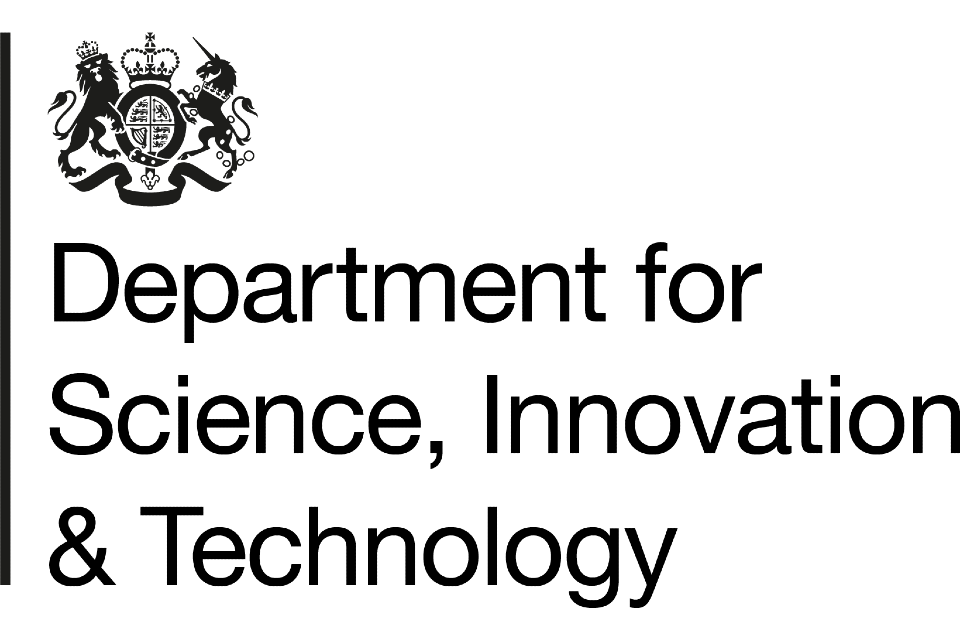
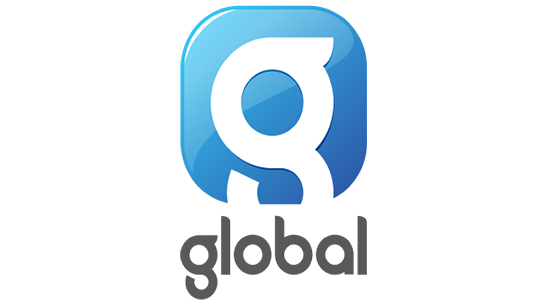


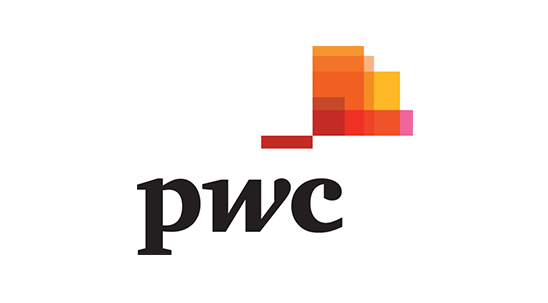
Supporting Partners
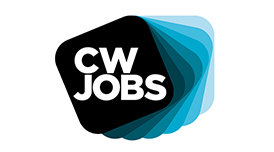
And additional thanks to
.png)
Individual thanks and credits to Lexie Papaspyrou, Karen Blake, Liz Chapman, Charl Fontini and Armand Fourie.
Methodology
To find our more about our methodology, click here.